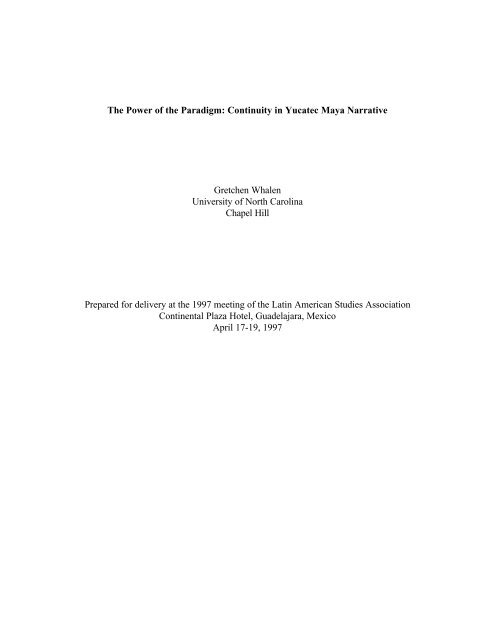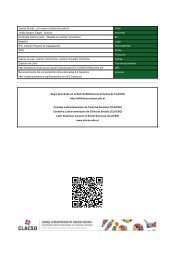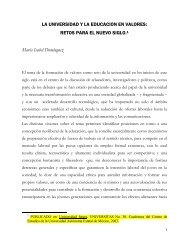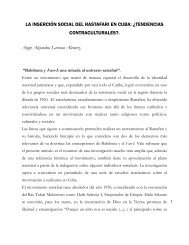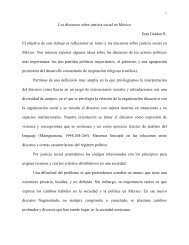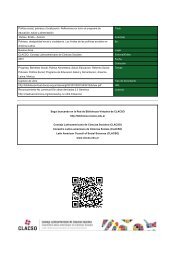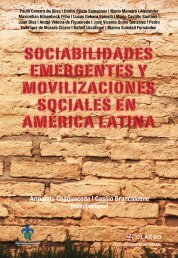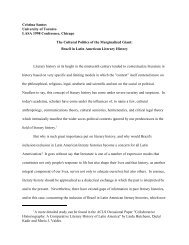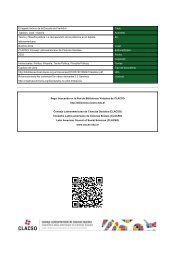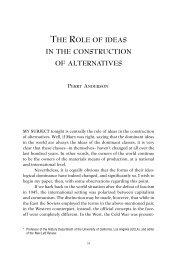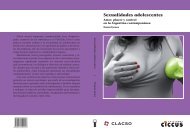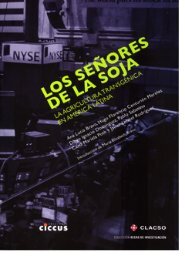The Power of the Paradigm: Continuity in Yucatec Maya Narrative ...
The Power of the Paradigm: Continuity in Yucatec Maya Narrative ...
The Power of the Paradigm: Continuity in Yucatec Maya Narrative ...
Create successful ePaper yourself
Turn your PDF publications into a flip-book with our unique Google optimized e-Paper software.
<strong>The</strong> <strong>Power</strong> <strong>of</strong> <strong>the</strong> <strong>Paradigm</strong>: <strong>Cont<strong>in</strong>uity</strong> <strong>in</strong> <strong>Yucatec</strong> <strong>Maya</strong> <strong>Narrative</strong><br />
Gretchen Whalen<br />
University <strong>of</strong> North Carol<strong>in</strong>a<br />
Chapel Hill<br />
Prepared for delivery at <strong>the</strong> 1997 meet<strong>in</strong>g <strong>of</strong> <strong>the</strong> Lat<strong>in</strong> American Studies Association<br />
Cont<strong>in</strong>ental Plaza Hotel, Guadelajara, Mexico<br />
April 17-19, 1997
<strong>Cont<strong>in</strong>uity</strong> <strong>in</strong> <strong>Yucatec</strong> <strong>Maya</strong> <strong>Narrative</strong><br />
I would like to beg<strong>in</strong> my discussion <strong>of</strong> cont<strong>in</strong>uity <strong>in</strong> <strong>Yucatec</strong> <strong>Maya</strong> narrative by<br />
present<strong>in</strong>g my translation <strong>of</strong> a story written <strong>in</strong> <strong>Yucatec</strong> by José Joaquín Balam Che'.<br />
Joaquín is a scholar <strong>of</strong> <strong>Yucatec</strong> <strong>Maya</strong> who teaches at <strong>the</strong> Casa de la Cultura <strong>in</strong> Felipe<br />
Carrillo Puerto, Qu<strong>in</strong>tana Roo. In addition to hav<strong>in</strong>g composed a grammar textbook for<br />
use <strong>in</strong> his classes, Joaquín writes various k<strong>in</strong>ds <strong>of</strong> stories, from animal tales to<br />
ethnographic descriptions <strong>of</strong> traditional ceremonies. However, he emphasizes <strong>the</strong><br />
importance <strong>of</strong> historical accounts, <strong>of</strong> which <strong>the</strong> follow<strong>in</strong>g story is an example. He hopes to<br />
compile a history <strong>of</strong> <strong>the</strong> Caste War while <strong>the</strong> old people who remember it are still alive to<br />
tell <strong>the</strong>ir stories. My analysis <strong>of</strong> Joaquín's narrative will place it <strong>in</strong> <strong>the</strong> contexts <strong>of</strong> <strong>Maya</strong><br />
history and <strong>Maya</strong> literature, trac<strong>in</strong>g paradigms that structured earlier texts and that<br />
cont<strong>in</strong>ue to shape contemporary narrative.<br />
<strong>The</strong> <strong>Maya</strong> language has a long written history, with literature dat<strong>in</strong>g back over two<br />
millenia, but today authors <strong>in</strong> <strong>Yucatec</strong> <strong>Maya</strong> are few. In <strong>the</strong>ir essay titled "<strong>Yucatec</strong>an<br />
<strong>Maya</strong>n Literature" written <strong>in</strong> 1985, Munro Edmonson and Victoria Bricker state, "<strong>the</strong>re is<br />
nei<strong>the</strong>r a demand nor a vehicle for <strong>Maya</strong>n literary expression today" (1985:58). While this<br />
is not entirely true <strong>of</strong> <strong>the</strong> present, never<strong>the</strong>less, contemporary written texts are scarce.<br />
Most studies <strong>of</strong> modern <strong>Yucatec</strong> literature analyze transcriptions <strong>of</strong> recorded narratives,<br />
part <strong>of</strong> <strong>the</strong> vital oral tradition <strong>of</strong> <strong>the</strong> <strong>Maya</strong> region, a tradition which susta<strong>in</strong>s and <strong>in</strong>forms<br />
<strong>Maya</strong> writ<strong>in</strong>g. However, Joaquín's story <strong>of</strong>fers us a unique opportunity to experience<br />
<strong>Maya</strong> narrative as it is written today by a native speaker. Valuable as literature <strong>in</strong> its own<br />
right, Joaquín's writ<strong>in</strong>g also reveals patterns <strong>of</strong> conceptualization and language use which<br />
may be traced back through generations <strong>of</strong> <strong>Maya</strong> narrative.<br />
Joaquín titles <strong>the</strong> follow<strong>in</strong>g account U Tsikbalil le Noj K'ak'o, which I translate as<br />
"<strong>The</strong> Story <strong>of</strong> <strong>the</strong> Smallpox Epidemic." <strong>The</strong> term tsikbal means "conversation" <strong>in</strong><br />
<strong>Yucatec</strong>, because for <strong>the</strong> <strong>Maya</strong> storytell<strong>in</strong>g typically <strong>in</strong>volves co-narration. As Allan<br />
Burns discovered when he first tried to record stories <strong>in</strong> Yucatan, storytell<strong>in</strong>g requires<br />
both a "person who knows <strong>the</strong> stories" and a "person who knows how to answer <strong>the</strong><br />
speech" (Burns 1983: 22-23). <strong>The</strong> tradition <strong>of</strong> co-narration extends to written literature<br />
as well. Burns states, "<strong>Maya</strong>n literature, both oral and written takes care to <strong>in</strong>clude more<br />
than one speaker. . . Indeed one <strong>of</strong> <strong>the</strong> problems scholars have had <strong>in</strong> understand<strong>in</strong>g<br />
<strong>Maya</strong>n oral literature is <strong>the</strong> tremendous difference between European literary traditions<br />
and <strong>Maya</strong>n conversational traditions. <strong>The</strong> core concept <strong>of</strong> European thought and<br />
literature is <strong>the</strong> s<strong>in</strong>gular word, <strong>the</strong> legitimate and sole author" (Burns 1991: 36).<br />
When Joaquín first showed me "<strong>The</strong> Story <strong>of</strong> <strong>the</strong> Smallpox Epidemic," he<br />
described it as a story his grandmo<strong>the</strong>r had told him. Joaquín's grandmo<strong>the</strong>r was <strong>the</strong> only<br />
survivor <strong>of</strong> a smallpox epidemic which erased <strong>the</strong> town <strong>of</strong> Chun-on <strong>in</strong> <strong>the</strong> wake <strong>of</strong> <strong>the</strong><br />
Caste War. You will hear Joaquín's grandmo<strong>the</strong>r's voice <strong>in</strong> <strong>the</strong> tell<strong>in</strong>g. You will<br />
encounter a style <strong>of</strong> narration that allows not only for more than one voice, but for more<br />
than one emphasis or po<strong>in</strong>t <strong>of</strong> view.<br />
My goal <strong>in</strong> translation is to present a read<strong>in</strong>g as close as possible to <strong>the</strong> orig<strong>in</strong>al<br />
<strong>Maya</strong>, easily followed and easily critiqued by anyone who knows <strong>the</strong> language. <strong>The</strong><br />
challenge is to create a readable text <strong>in</strong> English without obscur<strong>in</strong>g <strong>the</strong> mean<strong>in</strong>g or form <strong>of</strong><br />
1
<strong>the</strong> <strong>Maya</strong>. To this end, I have chosen to rearrange Joaquín's text <strong>in</strong>to l<strong>in</strong>es based on <strong>the</strong><br />
connections between ideas as <strong>the</strong>y are reflected <strong>in</strong> <strong>Yucatec</strong> grammar. I have also<br />
numbered <strong>the</strong> sections with<strong>in</strong> Joaquín's text to facilitate my discussion <strong>of</strong> it.<br />
<strong>The</strong> Story <strong>of</strong> <strong>the</strong> Smallpox Epidemic<br />
(1)<br />
It happened back <strong>the</strong>n <strong>in</strong> <strong>the</strong> year 15,<br />
back before I had been born here on earth;<br />
my grandparents lived <strong>in</strong> that o<strong>the</strong>r time:<br />
<strong>the</strong>ir names were Apol<strong>in</strong>aria Cach and Antonio Che'.<br />
<strong>The</strong>y lived with great sadness and also <strong>in</strong> suffer<strong>in</strong>g,<br />
because <strong>of</strong> those sicknesses back <strong>the</strong>n,<br />
caused by that battle with <strong>the</strong> foreigners<br />
who came to seize that town.<br />
(2)<br />
Because those foreigners, it's <strong>the</strong>irs, <strong>the</strong> evil <strong>of</strong> smallpox,<br />
because only <strong>the</strong>y brought it, this death to <strong>the</strong> town,<br />
because it's <strong>the</strong>ir sickness that <strong>in</strong>fected us:<br />
known as smallpox,<br />
bitterly suffered <strong>in</strong> those years.<br />
(3)<br />
Before <strong>the</strong> arrival <strong>of</strong> <strong>the</strong> foreigners to <strong>the</strong> land <strong>of</strong> <strong>the</strong> <strong>Maya</strong>,<br />
<strong>the</strong>re was for all <strong>the</strong>ir generations,<br />
a good life and happ<strong>in</strong>ess;<br />
when <strong>the</strong>y arrived, o<strong>the</strong>r men with different th<strong>in</strong>k<strong>in</strong>g,<br />
<strong>the</strong>y distorted our th<strong>in</strong>k<strong>in</strong>g;<br />
as for why it happened,<br />
<strong>the</strong>y exploited us, along with our family members.<br />
Thus <strong>the</strong>y gave discord to our thought;<br />
<strong>the</strong>y harmed our body.<br />
(4)<br />
Because as for us, so was our th<strong>in</strong>k<strong>in</strong>g<br />
on <strong>the</strong> arrival <strong>of</strong> o<strong>the</strong>r, strange men here <strong>in</strong> our town:<br />
we thought <strong>the</strong>m not like us;<br />
because <strong>of</strong> th<strong>in</strong>k<strong>in</strong>g we see men<br />
different from our l<strong>in</strong>eages<br />
<strong>the</strong>refore, we saw ourselves <strong>in</strong> those first days,<br />
given fear and loss <strong>of</strong> heart.<br />
Because <strong>of</strong> that, those men will lord over us.<br />
2
(5)<br />
<strong>The</strong> ancient name <strong>of</strong> this town was Chun-on,<br />
where, at dawn one day,<br />
it was made known among its leaders,<br />
that it is arriv<strong>in</strong>g, this evil sickness,<br />
that will br<strong>in</strong>g an end to <strong>the</strong> life <strong>of</strong> this town<br />
because it will make an end to all its leaders.<br />
(6a)<br />
Only by <strong>the</strong> compassion <strong>of</strong> Lord God<br />
was cont<strong>in</strong>u<strong>in</strong>g <strong>the</strong> life <strong>of</strong> one young girl;<br />
she was named Apol<strong>in</strong>aria Cach;<br />
she was ten years old.<br />
She told those th<strong>in</strong>gs that happened back <strong>the</strong>n<br />
because she didn't suffer <strong>the</strong> sickness;<br />
only one pock broke out on <strong>the</strong> sole <strong>of</strong> her foot.<br />
S<strong>in</strong>ce she didn't succumb to it,<br />
she wanted to lend her life, to fulfill her desire<br />
to help her fellow people,<br />
who suffer bitterly with <strong>the</strong> pa<strong>in</strong> <strong>of</strong> that sickness.<br />
As for her <strong>in</strong> her childhood,<br />
no one was her guardian,<br />
nei<strong>the</strong>r her parents nor her older bro<strong>the</strong>rs,<br />
because all have died on account <strong>of</strong> that smallpox.<br />
<strong>The</strong>refore, she really experienced that entire sickness<br />
<strong>in</strong> her own flesh, that pa<strong>in</strong>ful life,<br />
that entire town completely stilled.<br />
Because by night and also by day<br />
are heard <strong>the</strong> shouts and delirium<br />
<strong>of</strong> those poor sick people.<br />
On account <strong>of</strong> <strong>the</strong> cont<strong>in</strong>uous pa<strong>in</strong> that has seized <strong>the</strong>ir bodies,<br />
because thus <strong>the</strong>y are protected, those sick people,<br />
<strong>the</strong>y are made to lie down on very s<strong>of</strong>t banana leaves,<br />
because thus <strong>the</strong>y are protected, those sick people,<br />
so not to lacerate <strong>the</strong> wounds on <strong>the</strong>ir bodies<br />
because <strong>the</strong>y are rubbed by stick<strong>in</strong>g to <strong>the</strong> hammock like this;<br />
it stops really wound<strong>in</strong>g <strong>the</strong>ir bodies<br />
and really scrap<strong>in</strong>g <strong>the</strong>ir sk<strong>in</strong>s<br />
so that it becomes possible to suffer its pa<strong>in</strong><br />
because always <strong>the</strong>y must die from this sickness.<br />
(6b)<br />
As for what she also tells:<br />
from those small houses where she passes,<br />
3
she hears <strong>the</strong>ir shouts, those sick people,<br />
<strong>the</strong>y are ask<strong>in</strong>g for water.<br />
Only when she takes it to <strong>the</strong>m,<br />
she br<strong>in</strong>gs it close to <strong>the</strong> mouths <strong>of</strong> those sick people,<br />
<strong>the</strong>y can't dr<strong>in</strong>k it because <strong>the</strong>y have become too sick.<br />
All that water,<br />
it all flows down <strong>the</strong>ir bodies.<br />
No days passed without deaths<br />
<strong>the</strong>re <strong>in</strong> all those houses,<br />
so she saw herself, with so many th<strong>in</strong>gs,<br />
unable to do anyth<strong>in</strong>g just by herself,<br />
on behalf <strong>of</strong> those dead<br />
because <strong>of</strong> all <strong>the</strong> leaders <strong>of</strong> that town.<br />
So every day all <strong>the</strong> leaders <strong>of</strong> that town,<br />
are just completely devoured by dogs<br />
<strong>in</strong>side <strong>the</strong>ir town and even <strong>in</strong>side <strong>the</strong>ir houses<br />
<strong>in</strong> that o<strong>the</strong>r time<br />
only <strong>in</strong> sorrow and <strong>in</strong> compassion<br />
<strong>in</strong> <strong>the</strong> middle <strong>of</strong> <strong>the</strong> forest <strong>of</strong> <strong>the</strong> <strong>Maya</strong>.<br />
Under <strong>the</strong>ir hammocks<br />
is seen dripp<strong>in</strong>g <strong>the</strong>ir water<br />
because <strong>the</strong>ir bodies have really rotted<br />
on account <strong>of</strong> that sickness.<br />
S<strong>in</strong>ce <strong>the</strong>re is no where for <strong>the</strong>m to recover<br />
<strong>the</strong>y have become reddened flesh, those bodies <strong>of</strong> <strong>the</strong>irs.<br />
In <strong>the</strong> middle <strong>of</strong> <strong>the</strong> town,<br />
<strong>the</strong>re <strong>the</strong>y battle each o<strong>the</strong>r, those dogs,<br />
over <strong>the</strong> <strong>in</strong>test<strong>in</strong>es <strong>of</strong> those men.<br />
(7)<br />
It turned, <strong>the</strong>n, <strong>the</strong>ir town<br />
thus to a grave,<br />
today.<br />
We have known this town thus:<br />
Chun-on Qu<strong>in</strong>tana Roo<br />
Historical Context<br />
Joaquín's story is his grandmo<strong>the</strong>r's story. It is also <strong>the</strong> story <strong>of</strong> a people, <strong>the</strong><br />
Cruzob <strong>Maya</strong>, who cont<strong>in</strong>ued <strong>the</strong>ir resistance to dom<strong>in</strong>ation by outsiders through <strong>the</strong> early<br />
decades <strong>of</strong> this century. For <strong>the</strong> Cruzob <strong>Maya</strong>, <strong>the</strong> Caste War did not end with <strong>the</strong><br />
occupation <strong>of</strong> <strong>the</strong>ir capital by Mexican forces <strong>in</strong> 1901. Threatened with <strong>in</strong>vasion and <strong>the</strong><br />
4
capture <strong>of</strong> <strong>the</strong> miraculous Cross which hallowed <strong>the</strong>ir struggle, <strong>Maya</strong> leaders chose to<br />
abandon <strong>the</strong> town <strong>of</strong> Chan Santa Cruz (now known as Felipe Carrillo Puerto), carry<strong>in</strong>g<br />
<strong>the</strong>ir sacred symbol with <strong>the</strong>m. <strong>The</strong>y regrouped <strong>in</strong> towns like Chun-on, hidden "<strong>in</strong> <strong>the</strong><br />
middle <strong>of</strong> <strong>the</strong> forest <strong>of</strong> <strong>the</strong> <strong>Maya</strong>," where <strong>the</strong>y ma<strong>in</strong>ta<strong>in</strong>ed <strong>the</strong>ir political and religious<br />
<strong>in</strong>stitutions dur<strong>in</strong>g <strong>the</strong> years that <strong>the</strong>ir capital, Chan Santa Cruz, was held by General<br />
Ignacio Bravo's army. When <strong>the</strong> Mexican soldiers withdrew, <strong>the</strong> <strong>Maya</strong> re-entered Chan<br />
Santa Cruz and systematically destroyed <strong>the</strong> "improvements" wrought by outsiders,<br />
tear<strong>in</strong>g out rail l<strong>in</strong>es and telegraph wires, dynamit<strong>in</strong>g <strong>the</strong> new reservoir and burn<strong>in</strong>g <strong>the</strong><br />
barracks (Reed 1964: 250). At this critical juncture <strong>in</strong> Cruzob history,"back <strong>the</strong>n <strong>in</strong> <strong>the</strong><br />
year 15," <strong>the</strong> smallpox epidemic struck. Accord<strong>in</strong>g to some accounts, God sent <strong>the</strong><br />
epidemic to punish <strong>the</strong> <strong>Maya</strong> for fail<strong>in</strong>g to protect <strong>the</strong> sacred city.<br />
Joaquín's story does not stress <strong>the</strong> <strong>the</strong>me <strong>of</strong> div<strong>in</strong>e retribution, focus<strong>in</strong>g ra<strong>the</strong>r on<br />
<strong>the</strong> role <strong>of</strong> foreigners as bearers <strong>of</strong> sickness. In <strong>Maya</strong> this attribution <strong>of</strong> blame is even<br />
stronger than <strong>in</strong> English translation; Joaquín employs a stative construction <strong>in</strong> which <strong>the</strong><br />
foreigners are literally equated with <strong>the</strong> evil <strong>of</strong> smallpox. Joaquín suggests <strong>the</strong> secondary<br />
<strong>the</strong>me <strong>of</strong> sickness as punishment by us<strong>in</strong>g <strong>the</strong> word yum to refer to <strong>the</strong> victims <strong>of</strong><br />
smallpox. Yum may mean fa<strong>the</strong>r, lord or leader. Here it cites <strong>the</strong> decision-makers for <strong>the</strong><br />
community, <strong>the</strong> leaders who decided to withdraw from Chan Santa Cruz. In Joaquín's<br />
story, <strong>the</strong> most explicit passage l<strong>in</strong>k<strong>in</strong>g <strong>the</strong> failure <strong>of</strong> leadership to <strong>the</strong> destruction <strong>of</strong> <strong>the</strong><br />
town <strong>of</strong> Chun-on states," <strong>The</strong> ancient name <strong>of</strong> this town was Chun-on,/ where, at dawn<br />
one day,/ it was made known among its leaders,/ that it is arriv<strong>in</strong>g, this evil sickness,/ that<br />
will br<strong>in</strong>g an end to <strong>the</strong> life <strong>of</strong> this town/ because it will make an end to all its leaders."<br />
Joaquín stresses one <strong>the</strong>me but subtly <strong>in</strong>troduces a second <strong>the</strong>me that could be developed<br />
by a co-narrator if <strong>the</strong> story were performed as tsikbal, conversation. His narrative allows<br />
for more than one voice and more than one po<strong>in</strong>t <strong>of</strong> view.<br />
Ano<strong>the</strong>r recount<strong>in</strong>g <strong>of</strong> <strong>the</strong> epidemic <strong>of</strong> 1915 appears <strong>in</strong> Alfonso Villa<br />
Rojas' ethnography <strong>of</strong> <strong>the</strong> Cruzob <strong>Maya</strong> titled Los Elegidos de Dios. In his chapter on <strong>the</strong><br />
pacification <strong>of</strong> Cruzob territory after <strong>the</strong> Caste War, Villa Rojas <strong>in</strong>cludes <strong>the</strong> follow<strong>in</strong>g<br />
text which he presents as <strong>the</strong> written statement <strong>of</strong> Mauricio Baas, a neighbor from<br />
Chuncunche' who was fifteen years old at <strong>the</strong> time <strong>of</strong> <strong>the</strong> epidemic. What follows is my<br />
translation from <strong>the</strong> Spanish:<br />
I was already clear<strong>in</strong>g <strong>in</strong> <strong>the</strong> milpa when <strong>the</strong> smallpox [began]. <strong>The</strong>n we were<br />
liv<strong>in</strong>g <strong>in</strong> Yaaxkax. I remember <strong>the</strong> sickness began <strong>in</strong> Chuncunche'. <strong>The</strong>n <strong>the</strong><br />
sickness was so strong that quickly everyone began to die. Those from Yaaxkax<br />
had to go out every day to bury those from Chuncunche'.<br />
Never<strong>the</strong>less, this didn't last long s<strong>in</strong>ce soon those from Yaaxkax began to<br />
die also. When <strong>the</strong> sickness entered a house, almost always it killed everyone.<br />
First <strong>the</strong> old people died; f<strong>in</strong>ally <strong>the</strong> children. In many cases <strong>the</strong> only ones<br />
rema<strong>in</strong><strong>in</strong>g alive were children a few months old. When <strong>the</strong> disease spread, many<br />
died <strong>of</strong> thirst from hav<strong>in</strong>g no one to give <strong>the</strong>m water. Just as little was <strong>the</strong>re any<br />
one to bury <strong>the</strong>m; <strong>the</strong> dogs entered <strong>the</strong> houses to devour <strong>the</strong>m. <strong>The</strong>re were sick<br />
people who, unable to endure <strong>the</strong> sight <strong>of</strong> <strong>the</strong>se scenes <strong>in</strong> <strong>the</strong>ir own family, went<br />
<strong>in</strong>sane and fled to <strong>the</strong> forest from which <strong>the</strong>y never returned.<br />
Some atta<strong>in</strong>ed health bath<strong>in</strong>g <strong>the</strong>mselves with <strong>the</strong> juice <strong>of</strong> x-mehen-nal<br />
(new corn). <strong>The</strong> bath is prepared by dilut<strong>in</strong>g <strong>in</strong> water <strong>the</strong> masa <strong>of</strong> raw x-mehen-<br />
5
nal. It was also good to take a dr<strong>in</strong>k <strong>of</strong> squash seed ground and dissolved <strong>in</strong><br />
water. When <strong>the</strong>y had someone to attend <strong>the</strong>m, <strong>the</strong> sick were laid down on<br />
cogollo de platano (shoots <strong>of</strong> banana); only thus could <strong>the</strong>y avoid hav<strong>in</strong>g <strong>the</strong><br />
cloth<strong>in</strong>g stick <strong>in</strong> <strong>the</strong> sores. Just <strong>in</strong> Yaaxkax died some 50. Many say that this<br />
sickness was sent by God, <strong>in</strong> punishment for not hav<strong>in</strong>g pursued <strong>the</strong> war aga<strong>in</strong>st<br />
<strong>the</strong> Mexicans who took control <strong>of</strong> Chan Santa Cruz. S<strong>in</strong>ce this was <strong>the</strong> fault <strong>of</strong> <strong>the</strong><br />
old men, so it was that <strong>the</strong> sickness took <strong>the</strong>m first. [1978:123]<br />
Mauricio Baas <strong>in</strong>cludes many <strong>of</strong> <strong>the</strong> same details as Joaquín: <strong>the</strong> need for water, <strong>the</strong> dogs<br />
enter<strong>in</strong>g <strong>the</strong> houses to devour <strong>the</strong> corpses, and <strong>the</strong> use <strong>of</strong> s<strong>of</strong>t banana leaves to cushion <strong>the</strong><br />
lacerated sk<strong>in</strong> <strong>of</strong> <strong>the</strong> victims. However, unlike Joaquín, he explicitly states <strong>the</strong> belief that<br />
God used <strong>the</strong> epidemic to punish <strong>Maya</strong> leaders for <strong>the</strong>ir failures. <strong>The</strong>re exists a third piece<br />
<strong>of</strong> literature that addresses <strong>the</strong> same <strong>the</strong>me. Accord<strong>in</strong>g to Nikolai Grube, among <strong>the</strong><br />
sacred papers preserved <strong>in</strong> <strong>the</strong> shr<strong>in</strong>e city <strong>of</strong> Tixcacal Guardia, is a letter written by <strong>the</strong><br />
scribe <strong>of</strong> <strong>the</strong> Cross which refers to Santo Noj K'ak', <strong>the</strong> holy smallpox, as God's way <strong>of</strong><br />
chastis<strong>in</strong>g <strong>the</strong> Cruzob for failure <strong>in</strong> battle (recorded lecture 1996).<br />
Joaquín's story, U Tsikbalil le Noj K'ak'o, relates family history and Caste War<br />
history. However, it also represents "<strong>the</strong> plague story," a genre <strong>of</strong> <strong>Maya</strong> narrative dat<strong>in</strong>g<br />
back at least to <strong>the</strong> sixteenth century. Colonial <strong>Maya</strong> texts like <strong>the</strong> Chilam Balam books<br />
and <strong>The</strong> Annals <strong>of</strong> <strong>the</strong> Cakchiquels <strong>in</strong>clude extant records <strong>of</strong> foreign <strong>in</strong>cursion and<br />
pestilence. However, Sanchez de Aguilar attests to earlier accounts <strong>of</strong> epidemics <strong>in</strong><br />
hieroglyphic books still <strong>in</strong> existence seventy years after <strong>the</strong> conquest, say<strong>in</strong>g, "<strong>in</strong> <strong>the</strong>se <strong>the</strong>y<br />
pa<strong>in</strong>ted <strong>in</strong> colors <strong>the</strong> count <strong>of</strong> <strong>the</strong>ir years, <strong>the</strong> wars, epidemics, hurricanes, <strong>in</strong>undations,<br />
fam<strong>in</strong>es and o<strong>the</strong>r events"(quoted <strong>in</strong> Roys 1933: 5). Both <strong>the</strong> Chilam Balam texts I quote<br />
here and <strong>The</strong> Annals <strong>of</strong> <strong>the</strong> Cakchiquels are separated by centuries from Joaquín's<br />
account. <strong>The</strong> Annals <strong>of</strong> <strong>the</strong> Cakchiquels, written <strong>in</strong> <strong>the</strong> highlands <strong>of</strong> Guatemala, is<br />
separated geographically and by language difference as well. As Allan Burns notes,<br />
"<strong>Maya</strong> studies have developed under <strong>the</strong> historic myth that highland and lowland people<br />
share very little o<strong>the</strong>r than a remote heritage and a protolanguage" (1994: 6). However,<br />
passages from <strong>the</strong>se texts show marked similarities to Joaquín's story, suggest<strong>in</strong>g a<br />
commonality <strong>of</strong> world view and <strong>of</strong> narrative convention that extends widely across both<br />
time and space <strong>in</strong> <strong>the</strong> <strong>Maya</strong> world.<br />
Two passages <strong>in</strong> Joaquín's plague story particularly echo l<strong>in</strong>es <strong>in</strong> <strong>the</strong><br />
Chilam Balam. One passage describes <strong>the</strong> golden age <strong>of</strong> health and happ<strong>in</strong>ess that existed<br />
for <strong>the</strong> <strong>Maya</strong> before <strong>the</strong> arrival <strong>of</strong> foreigners. <strong>The</strong> o<strong>the</strong>r recounts <strong>the</strong> total breakdown <strong>of</strong><br />
order caused by widespread disease, represented by animals devour<strong>in</strong>g corpses with<strong>in</strong> <strong>the</strong><br />
community's boundaries. Joaquín writes, "Before <strong>the</strong> arrival <strong>of</strong> <strong>the</strong> foreigners to <strong>the</strong> land<br />
<strong>of</strong> <strong>the</strong> <strong>Maya</strong>,/ <strong>the</strong>re was for all <strong>the</strong>ir generations,/ a good life and happ<strong>in</strong>ess." While he<br />
speaks here <strong>of</strong> <strong>the</strong> soldiers <strong>of</strong> General Bravo, he does so <strong>in</strong> a manner that allows reference<br />
to <strong>the</strong> Spanish conquest and to <strong>the</strong> repeat<strong>in</strong>g pattern <strong>of</strong> <strong>in</strong>vasions and subsequent<br />
pestilence suffered by <strong>the</strong> <strong>Maya</strong> people. <strong>The</strong> Book <strong>of</strong> Chilam Balam <strong>of</strong> Chumayel<br />
<strong>in</strong>cludes a fuller exposition <strong>of</strong> <strong>the</strong> same <strong>the</strong>me. Here I quote Ralph Roys' translation:<br />
<strong>The</strong>y did not wish to jo<strong>in</strong> with <strong>the</strong> foreigners; <strong>the</strong>y did not desire Christianity.<br />
<strong>The</strong>y did not wish to pay tribute, did those whose emblems were <strong>the</strong> bird, <strong>the</strong><br />
precious stone and <strong>the</strong> jaguar, those with <strong>the</strong> three magic emblems. Four four-<br />
6
hundreds <strong>of</strong> years and fifteen score years was <strong>the</strong> end <strong>of</strong> <strong>the</strong>ir lives; <strong>the</strong>n came <strong>the</strong><br />
end <strong>of</strong> <strong>the</strong>ir lives, because <strong>the</strong>y knew <strong>the</strong> measure <strong>of</strong> <strong>the</strong>ir days. Complete was <strong>the</strong><br />
month; complete, <strong>the</strong> year; complete, <strong>the</strong> day; complete, <strong>the</strong> night; complete <strong>the</strong><br />
breath <strong>of</strong> life as it passed also; complete, <strong>the</strong> blood, when <strong>the</strong>y arrived at <strong>the</strong>ir<br />
mats, <strong>the</strong>ir thrones. In due measure did <strong>the</strong>y recite <strong>the</strong> good prayers; <strong>in</strong> due<br />
measure <strong>the</strong>y sought <strong>the</strong> lucky days, until <strong>the</strong>y saw <strong>the</strong> good stars enter <strong>in</strong>to <strong>the</strong>ir<br />
reign; <strong>the</strong>n <strong>the</strong>y kept watch while <strong>the</strong>ir reign <strong>of</strong> <strong>the</strong> good stars began. <strong>The</strong>n<br />
everyth<strong>in</strong>g was good.<br />
<strong>The</strong>n <strong>the</strong>y adhered to <strong>the</strong> dictates <strong>of</strong> <strong>the</strong>ir reason. <strong>The</strong>re was no s<strong>in</strong>; <strong>in</strong> <strong>the</strong><br />
holy faith <strong>the</strong>ir lives were passed. <strong>The</strong>re was <strong>the</strong>n no sickness; <strong>the</strong>y had <strong>the</strong>n no<br />
ach<strong>in</strong>g bones; <strong>the</strong>y had <strong>the</strong>n no fever; <strong>the</strong>y had <strong>the</strong>n no smallpox; <strong>the</strong>y had <strong>the</strong>n no<br />
burn<strong>in</strong>g chest; <strong>the</strong>y had <strong>the</strong>n no abdom<strong>in</strong>al pa<strong>in</strong>s; <strong>the</strong>y had <strong>the</strong>n no consumption;<br />
<strong>the</strong>y had <strong>the</strong>n no headache. At that time <strong>the</strong> course <strong>of</strong> humanity was orderly.<br />
<strong>The</strong> foreigners made it o<strong>the</strong>rwise when <strong>the</strong>y arrived here. <strong>The</strong>y brought<br />
shameful th<strong>in</strong>gs when <strong>the</strong>y came.<br />
[1933:83]<br />
A few l<strong>in</strong>es later <strong>the</strong> text cont<strong>in</strong>ues, "No lucky days were <strong>the</strong>n displayed to<br />
us. This was <strong>the</strong> orig<strong>in</strong> <strong>of</strong> <strong>the</strong> two-day throne, <strong>of</strong> <strong>the</strong> two-day reign; this was <strong>the</strong> cause <strong>of</strong><br />
our sickness also." Joaquín presents an abbreviated account <strong>of</strong> "a good life and happ<strong>in</strong>ess"<br />
and focuses on a s<strong>in</strong>gle sickness, smallpox. Both accounts posit a <strong>Maya</strong> epoch without<br />
discord or disease. Both blame foreigners for its end and l<strong>in</strong>k <strong>in</strong>appropriate leadership<br />
with subsequent suffer<strong>in</strong>g to <strong>the</strong> community. (<strong>The</strong> word that Roys translates here as<br />
sickness is <strong>in</strong> fact cimil, death). Both seem to speak simultaneously <strong>of</strong> more than one<br />
<strong>in</strong>vasion. Accord<strong>in</strong>g to Roys, <strong>the</strong> Chumayel passage refers to both <strong>the</strong> bearers <strong>of</strong><br />
Christianity and to <strong>the</strong> Itza. <strong>The</strong> narrator sums up <strong>the</strong> situation: "Three times it was, <strong>the</strong>y<br />
say, that <strong>the</strong> foreigners arrived" (Roys 1933: 84). In this characteristically <strong>Maya</strong> tell<strong>in</strong>g <strong>of</strong><br />
history, at least as important as record<strong>in</strong>g specific events is <strong>the</strong> discernment <strong>of</strong> what Inga<br />
Clend<strong>in</strong>nen has termed, " <strong>the</strong> pattern <strong>of</strong> recurrence beh<strong>in</strong>d occurence"(Clend<strong>in</strong>nen 1987:<br />
135).<br />
Many entries <strong>in</strong> <strong>the</strong> Chilam Balam books condense narratives, merely list<strong>in</strong>g <strong>the</strong><br />
ma<strong>in</strong> events <strong>of</strong> <strong>the</strong> twenty year periods called katuns. Each katun ends on a numbered day<br />
bear<strong>in</strong>g <strong>the</strong> name Ahau, which labels <strong>the</strong> katun as a whole. Accord<strong>in</strong>g to traditional <strong>Maya</strong><br />
belief, <strong>the</strong> repetition <strong>of</strong> a given katun after 260 tuns, ritual years (or approximately 256<br />
solar years) br<strong>in</strong>gs a repetition <strong>of</strong> similar events. <strong>The</strong> <strong>Maya</strong> have written <strong>the</strong>ir history to<br />
highlight <strong>the</strong>se cycles, which provide <strong>in</strong>formation about <strong>the</strong> future as well as <strong>the</strong> past.<br />
In <strong>The</strong> <strong>Maya</strong> Chronicles, Daniel Br<strong>in</strong>ton quotes an account <strong>of</strong> <strong>the</strong> arrival <strong>of</strong> <strong>the</strong><br />
Spaniards as it is recorded <strong>in</strong> katun history: "<strong>The</strong> eleventh ahau: <strong>the</strong> mighty men came<br />
from <strong>the</strong> east, <strong>the</strong>y brought <strong>the</strong> sickness; <strong>the</strong>y arrived for <strong>the</strong> first time <strong>in</strong> this country we<br />
<strong>Maya</strong> men say <strong>in</strong> <strong>the</strong> year 1513" (1969 [1882]:162). Ano<strong>the</strong>r excerpt from <strong>the</strong> Chilam<br />
Balam <strong>of</strong> Tizim<strong>in</strong> recounts an epidemic. In <strong>Maya</strong>, <strong>the</strong> text reads: "Can ahau; uchci maya<br />
cimlal ocnakuchil ich paa" (1969 [1882]:142). Br<strong>in</strong>ton translates this, "<strong>The</strong> fourth ahau;<br />
<strong>the</strong> pestilence, <strong>the</strong> general death, took place <strong>in</strong> <strong>the</strong> fortress" (1969 [1882]:148). In a note,<br />
Br<strong>in</strong>ton elaborates on <strong>the</strong> mean<strong>in</strong>g <strong>of</strong> ocnakuchil, which he has translated as "<strong>the</strong> general<br />
death": "<strong>The</strong> derivation <strong>of</strong> this word is stated to be from ocol, to enter, na, <strong>the</strong> houses,<br />
7
kuch, <strong>the</strong> crow or buzzard, <strong>the</strong> number <strong>of</strong> <strong>the</strong> dead be<strong>in</strong>g so great that <strong>the</strong> carrion birds<br />
entered <strong>the</strong> dwell<strong>in</strong>gs to prey upon <strong>the</strong> bodies" (1969 [1882]:151).<br />
When Joaquín writes, "So every day all <strong>the</strong> leaders <strong>of</strong> that town are just completely<br />
devoured by dogs, <strong>in</strong>side <strong>the</strong>ir town and even <strong>in</strong>side <strong>the</strong>ir houses," he echoes this<br />
traditional lament, substitut<strong>in</strong>g dogs for <strong>the</strong> carrion birds mentioned <strong>in</strong> <strong>the</strong> earlier account.<br />
<strong>The</strong> entrance <strong>in</strong>side <strong>the</strong> boundaries <strong>of</strong> community and home by scavengers represents a<br />
terrible violation <strong>of</strong> order <strong>in</strong> <strong>the</strong> human world as <strong>the</strong> <strong>Maya</strong> understand it. To appreciate its<br />
significance <strong>in</strong> <strong>Maya</strong> discourse, requires some awareness <strong>of</strong> <strong>the</strong> importance <strong>of</strong> boundaries<br />
<strong>in</strong> <strong>Maya</strong> thought. Lay<strong>in</strong>g out <strong>the</strong> borders creates order <strong>in</strong> both <strong>the</strong> spiritual and <strong>the</strong><br />
mundane realms. <strong>The</strong> shaman def<strong>in</strong>es ritual space by establish<strong>in</strong>g its four corners and<br />
center, as William Hanks describes <strong>in</strong> an article titled "Sanctification, Structure, and<br />
Experience <strong>in</strong> a <strong>Yucatec</strong> Ritual Event" (1984:135-8). In a similar way, "<strong>The</strong> milpa,<br />
homestead, and town are all embodied with guardian spirits at <strong>the</strong> canonical po<strong>in</strong>ts which<br />
protect <strong>the</strong> space from evil" (1984:136). Even <strong>the</strong> <strong>in</strong>itial Creation <strong>of</strong> <strong>the</strong> world described<br />
<strong>in</strong> <strong>the</strong> Popol Vuh follows <strong>the</strong> same pattern, with <strong>the</strong> Creator replicat<strong>in</strong>g <strong>the</strong> actions <strong>of</strong><br />
lay<strong>in</strong>g out a cornfield or houseplot:<br />
<strong>The</strong> fourfold sid<strong>in</strong>g, fourfold corner<strong>in</strong>g,<br />
measur<strong>in</strong>g, fourfold stak<strong>in</strong>g<br />
halv<strong>in</strong>g <strong>the</strong> cord, stretch<strong>in</strong>g <strong>the</strong> cord<br />
<strong>in</strong> <strong>the</strong> sky, on <strong>the</strong> earth,<br />
<strong>the</strong> four sides, <strong>the</strong> four corners. . . .<br />
[Tedlock1985:7]<br />
Dogs or vultures runn<strong>in</strong>g rampant with<strong>in</strong> <strong>the</strong> walls implies a complete violation <strong>of</strong><br />
established order, synonymous with general death and catastrophe. This charged image<br />
persists through time to represent <strong>the</strong> recurr<strong>in</strong>g disaster <strong>of</strong> plague.<br />
<strong>The</strong> Chilam Balam books outl<strong>in</strong>e epidemics, chart <strong>the</strong>ir frequency, and attribute<br />
blame to foreigners for <strong>the</strong>ir occurrence. None <strong>of</strong> <strong>the</strong> published texts from <strong>the</strong>se books<br />
<strong>in</strong>cludes detailed, eyewitness plague stories like Joaquín's story, U Tsikbalil le Noj K'ak'o.<br />
However, <strong>the</strong> follow<strong>in</strong>g passages from <strong>The</strong> Annals <strong>of</strong> <strong>the</strong> Cakchiquels reveal <strong>the</strong> plague<br />
story as a fully developed narrative type as early as <strong>the</strong> sixteenth century.<br />
It happened that dur<strong>in</strong>g <strong>the</strong> twenty-fifth year <strong>the</strong> plague began, oh, my<br />
sons! First <strong>the</strong>y became ill <strong>of</strong> a cough, <strong>the</strong>y suffered from nosebleeds and<br />
illness <strong>of</strong> <strong>the</strong> bladder. It was truly terrible <strong>the</strong> number <strong>of</strong> dead <strong>the</strong>re were <strong>in</strong><br />
that period. . . . Little by little heavy shadows and black night enveloped<br />
our fa<strong>the</strong>rs and grandfa<strong>the</strong>rs and us also, oh, my sons! when <strong>the</strong> plague<br />
raged. . . . On <strong>the</strong> day 5 Ah [March 12, 1521] our grandfa<strong>the</strong>rs started a<br />
war aga<strong>in</strong>st Pantacat [<strong>the</strong> present city <strong>of</strong> Escu<strong>in</strong>tla], when <strong>the</strong> plague began<br />
to spread. It was <strong>in</strong> truth terrible, <strong>the</strong> number <strong>of</strong> dead among <strong>the</strong> people.<br />
<strong>The</strong> people could not <strong>in</strong> any way control <strong>the</strong> sickness.<br />
8
Forty days after <strong>the</strong> epidemic began, our fa<strong>the</strong>r and grandfa<strong>the</strong>r died; on<br />
<strong>the</strong> day 12 Camey [April 14, 1521] <strong>the</strong> k<strong>in</strong>g Hunyg, your greatgrandfa<strong>the</strong>r,<br />
died.<br />
Two days later died also our fa<strong>the</strong>r, <strong>the</strong> Ahpop Achi Balam, your<br />
grandfa<strong>the</strong>r, oh, my sons! Our grandfa<strong>the</strong>rs and fa<strong>the</strong>rs died toge<strong>the</strong>r.<br />
Great was <strong>the</strong> stench <strong>of</strong> <strong>the</strong> dead. After our fa<strong>the</strong>rs and grandfa<strong>the</strong>rs<br />
succumbed, half <strong>of</strong> <strong>the</strong> people fled to <strong>the</strong> fields. <strong>The</strong> dogs and vultures<br />
devoured <strong>the</strong> bodies. <strong>The</strong> mortality was terrible. Your grandfa<strong>the</strong>rs died,<br />
and with <strong>the</strong>m died <strong>the</strong> son <strong>of</strong> <strong>the</strong> k<strong>in</strong>g and his bro<strong>the</strong>rs and k<strong>in</strong>smen. So it<br />
was that we became orphans, oh, my sons! So we became when we were<br />
young. All <strong>of</strong> us were thus. We were born to die!<br />
[Goetz 1953:115-6]<br />
Like Joaquín's story, this account tells a family story as <strong>the</strong> story <strong>of</strong> a people. Both<br />
narratives record graphic details, <strong>in</strong>clud<strong>in</strong>g <strong>the</strong> mutilation <strong>of</strong> bodies by animals, here both<br />
dogs and vultures. Both use couplet<strong>in</strong>g and repetition to emphasize <strong>the</strong> tone <strong>of</strong> lament.<br />
<strong>The</strong> Cakchiquel chronicle emphasizes time and l<strong>in</strong>eage, elements less developed <strong>in</strong> U<br />
Tsikbalil le Noj K'ak'o. Joaqu<strong>in</strong> sets <strong>the</strong> time as "back <strong>the</strong>n <strong>in</strong> <strong>the</strong> year 15." <strong>The</strong><br />
Cakchiquel narrator beg<strong>in</strong>s similarly, "It happened that dur<strong>in</strong>g <strong>the</strong> twenty-fifth year," but<br />
<strong>the</strong>n specifies <strong>the</strong> exact days on which events occurred. Joaquín names his maternal<br />
grandparents but does not o<strong>the</strong>rwise trace his l<strong>in</strong>eage. However, because <strong>the</strong> Cakchiquel<br />
narrator comes from <strong>the</strong> rul<strong>in</strong>g family, <strong>the</strong> issue <strong>of</strong> l<strong>in</strong>eage looms large <strong>in</strong> his account. In<br />
Daniel Br<strong>in</strong>ton's translation <strong>of</strong> <strong>The</strong> Annals <strong>of</strong> <strong>the</strong> Cakchiquels, <strong>the</strong> passage quoted above<br />
ends: "Thus did we become poor, O my children, and thus did we survive, be<strong>in</strong>g but a<br />
little child--and we were all that rema<strong>in</strong>ed. Hence <strong>the</strong> putt<strong>in</strong>g aside <strong>of</strong> our claims" (1969<br />
[1885]:171).<br />
In <strong>The</strong> Annals <strong>of</strong> <strong>the</strong> Cakchiquels, <strong>the</strong> specific details <strong>of</strong> family history and <strong>the</strong><br />
issue <strong>of</strong> claims supercede <strong>the</strong> concern with patterns <strong>of</strong> recurrence which frequently creates<br />
ambiguity <strong>in</strong> <strong>the</strong> tell<strong>in</strong>g <strong>of</strong> <strong>Maya</strong> history. <strong>Narrative</strong>s which telescope time to conflate<br />
<strong>in</strong>vasions separated by centuries, which seem to speak simultaneously <strong>of</strong> <strong>the</strong> Spaniards<br />
and <strong>the</strong> Itza, or <strong>of</strong> <strong>the</strong> Mexican army and <strong>the</strong> conquistadors, can prove disconcert<strong>in</strong>g to<br />
non-<strong>Maya</strong> readers who expect a l<strong>in</strong>ear recount<strong>in</strong>g <strong>of</strong> history. Judg<strong>in</strong>g <strong>Maya</strong> historical<br />
writ<strong>in</strong>g from a non-<strong>Maya</strong> perspective, Munro Edmonson concludes, "Throughout <strong>the</strong><br />
Annals[<strong>of</strong> <strong>the</strong> Cakchiquels] <strong>the</strong>re is a preoccupation with precise record<strong>in</strong>g <strong>of</strong> events and<br />
<strong>the</strong>ir chronological sequence which makes <strong>the</strong>m <strong>the</strong> best historical writ<strong>in</strong>g <strong>in</strong> Middle<br />
America's Indian literature" (Edmonson 1967: 360). However, <strong>the</strong> Chilam Balam books<br />
represent ano<strong>the</strong>r philosophy <strong>of</strong> history: "Oxlahun kal hab, ca zutnac lae tucaten layili:<br />
Thirteen score years and <strong>the</strong>n it will always return aga<strong>in</strong>" (Roys 1933: 52). In her<br />
exploration <strong>of</strong> <strong>the</strong> "historical substrate <strong>of</strong> <strong>Maya</strong> myth," <strong>The</strong> Indian Christ, <strong>The</strong> Indian<br />
K<strong>in</strong>g, Victoria Bricker concludes, "<strong>The</strong> temporal distortion which treats sequential events<br />
as structurally equivalent and <strong>in</strong>terchangeable is a logical consequence <strong>of</strong> <strong>the</strong> <strong>Maya</strong><br />
9
concept <strong>of</strong> time" (1981:181). As far as I know, no one keeps <strong>the</strong> katun count <strong>in</strong> Yucatan<br />
nowadays. However, <strong>the</strong> pattern for tell<strong>in</strong>g history cont<strong>in</strong>ues <strong>in</strong>to <strong>the</strong> present. As Bricker<br />
states, "Because history repeats itself, all ethnic conflicts can be reduced to a common<br />
structure which serves as an epistemological paradigm for understand<strong>in</strong>g new ethnic<br />
conflicts when <strong>the</strong>y arise. It constitutes <strong>the</strong> <strong>Maya</strong>'s <strong>the</strong>ory <strong>of</strong> knowledge, <strong>the</strong>ir<br />
metahistorical model for <strong>in</strong>terpret<strong>in</strong>g recurrent events" (1981:181).<br />
Literary Context<br />
Important as an example <strong>of</strong> <strong>the</strong> <strong>Maya</strong> way <strong>of</strong> tell<strong>in</strong>g history, Joaquín's story also<br />
reveals patterns <strong>of</strong> poetic structur<strong>in</strong>g which may be traced back to <strong>the</strong> Classic era. Writ<strong>in</strong>g<br />
<strong>of</strong> Native American ethnopoetics, Dell Hymes states, "If we do not deal with <strong>the</strong> means,<br />
we cannot possess <strong>the</strong> mean<strong>in</strong>g." He elaborates:<br />
If we refuse to consider and <strong>in</strong>terpret <strong>the</strong> surpris<strong>in</strong>g fact <strong>of</strong> device, design<br />
and performance <strong>in</strong>herent <strong>in</strong> <strong>the</strong> words <strong>of</strong> <strong>the</strong> texts, <strong>the</strong> Indians who made<br />
<strong>the</strong> texts, and those who preserved what <strong>the</strong>y made, will have worked <strong>in</strong><br />
va<strong>in</strong>. We will be tell<strong>in</strong>g <strong>the</strong> texts not to speak. [1981:5]<br />
Allan Burns stresses <strong>the</strong> same <strong>the</strong>me <strong>in</strong> an article titled "<strong>Yucatec</strong> <strong>Maya</strong> Ethnopoetics: <strong>the</strong><br />
Translation <strong>of</strong> a <strong>Narrative</strong> View <strong>of</strong> Life" where he states, "Understand<strong>in</strong>g <strong>the</strong>se<br />
conventions can provide access to <strong>Yucatec</strong> <strong>Maya</strong>n oral literature and <strong>Yucatec</strong> <strong>Maya</strong><br />
thought. Ethnopoetics is a means by which <strong>the</strong> oral literature can be translated and made<br />
available to an audience beyond speakers <strong>of</strong> <strong>Yucatec</strong> <strong>Maya</strong>n" (1980:3). While I hope that<br />
<strong>the</strong> follow<strong>in</strong>g discussion will enhance understand<strong>in</strong>g <strong>of</strong> Joaquín's story, I encourage<br />
learn<strong>in</strong>g <strong>the</strong> language to appreciate <strong>the</strong> literature.<br />
In approach<strong>in</strong>g a <strong>Maya</strong> text like Joaquín's, keep<strong>in</strong>g two precepts <strong>in</strong> m<strong>in</strong>d will<br />
prove helpful. First, <strong>Maya</strong> writ<strong>in</strong>g has a long history and canons <strong>of</strong> is own. Second, <strong>Maya</strong><br />
writ<strong>in</strong>g bears a close relation to <strong>the</strong> spoken word.<br />
In a workshop at <strong>the</strong> 1996 Philadelphia <strong>Maya</strong> meet<strong>in</strong>gs titled "Poetry <strong>in</strong> Ritual<br />
Inscriptions," Nicholas Hopk<strong>in</strong>s analyzed <strong>the</strong> poetic structure <strong>of</strong> ancient texts to establish<br />
<strong>the</strong>ir relation to <strong>Maya</strong> language use today. Accord<strong>in</strong>g to Hopk<strong>in</strong>s, <strong>the</strong> canons <strong>of</strong> Classic<br />
literature <strong>in</strong>clude a formal open<strong>in</strong>g and clos<strong>in</strong>g, sections with<strong>in</strong> <strong>the</strong> text deal<strong>in</strong>g with<br />
different topics us<strong>in</strong>g different syntax, <strong>the</strong> use <strong>of</strong> a "backstep <strong>in</strong> time" to <strong>in</strong>crease dramatic<br />
tension, and <strong>the</strong> use <strong>of</strong> metonyms, paired words which evoke a larger image. <strong>Maya</strong><br />
writ<strong>in</strong>g tends toward couplet<strong>in</strong>g. <strong>The</strong> more formal <strong>the</strong> genre and <strong>the</strong> more important <strong>the</strong><br />
event with<strong>in</strong> a text, <strong>the</strong> more sentences appear parallel <strong>in</strong> mean<strong>in</strong>g or structure. Chiasmic<br />
or nested couplet form represents <strong>the</strong> most complete elaboration <strong>of</strong> <strong>Maya</strong> literary style.<br />
However, <strong>Maya</strong> writ<strong>in</strong>g always implied performance ra<strong>the</strong>r than <strong>the</strong> silent read<strong>in</strong>g<br />
with which we are more familiar. Sanchez de Aguilar describes assemblies <strong>in</strong> which <strong>the</strong><br />
sixteenth century <strong>Maya</strong> sang and chanted to drumbeats <strong>the</strong> contents <strong>of</strong> hieroglyphic books<br />
(Roys 1933:5). In an <strong>in</strong>terest<strong>in</strong>g article titled "Pure Language and Lapidary Prose,"<br />
Clemency Chase Cogg<strong>in</strong>s "reads" <strong>the</strong> <strong>in</strong>scription on <strong>the</strong> south side <strong>of</strong> Stela A at Copan as<br />
it might have been performed by ritual specialists. Cogg<strong>in</strong>s expla<strong>in</strong>s that, "<strong>The</strong> written<br />
text supplied <strong>the</strong> necessary (if skeletal) structure while <strong>the</strong> priest or ruler who read it aloud<br />
would have transformed it <strong>in</strong>to couplets, triplets, and repetitions that were constra<strong>in</strong>ed<br />
10
only by his personal heat - his au<strong>the</strong>ntic religious correctness and <strong>in</strong>spiration" (1992:102).<br />
Even today, two scribes perform <strong>the</strong> sacred books once a year <strong>in</strong> <strong>the</strong> shr<strong>in</strong>e villages <strong>of</strong> <strong>the</strong><br />
Cruzob <strong>Maya</strong>, improvis<strong>in</strong>g on l<strong>in</strong>es considered <strong>the</strong> words <strong>of</strong> God (Burns 1983: 22-23).<br />
For texts that are written to be performed, sound is as important as structure. In a sense,<br />
Joaquín's story is a written record <strong>of</strong> an oration. He has chosen words for <strong>the</strong> effects<br />
created by sounds as well as for <strong>the</strong>ir mean<strong>in</strong>gs. He has improvised, us<strong>in</strong>g formulaic<br />
expressions, traditional <strong>the</strong>mes, Classic structure, and poetic devices.<br />
Joaquín's story starts with a formal open<strong>in</strong>g, plac<strong>in</strong>g it <strong>in</strong> time. <strong>The</strong> first l<strong>in</strong>e<br />
beg<strong>in</strong>s: Uchilak ti' jo'lajun jaabe', ka'ach ma' sijken way yok'ol kabe'. <strong>The</strong> word uchilak<br />
is a variant <strong>of</strong> <strong>the</strong> same word used as a focus marker <strong>in</strong> ancient texts to draw attention to<br />
key <strong>in</strong>formation; among glyphers it is called <strong>the</strong> anterior event <strong>in</strong>dicator. In <strong>the</strong> second<br />
clause, <strong>the</strong> word ka'ach emphasizes that <strong>the</strong> story is set <strong>in</strong> <strong>the</strong> past, <strong>the</strong> time before<br />
Joaquín's birth. Next Joaquín <strong>in</strong>troduces his grandmo<strong>the</strong>r, Apol<strong>in</strong>aria Cach, <strong>the</strong> survivor<br />
who told him <strong>the</strong> story, and her husband Antonio Che'. Thus he places himself with<strong>in</strong> his<br />
l<strong>in</strong>eage on his mo<strong>the</strong>r's side. <strong>The</strong> <strong>the</strong>mes <strong>of</strong> <strong>the</strong> story, <strong>the</strong> battle with <strong>the</strong> foreigners and<br />
<strong>the</strong> suffer<strong>in</strong>g caused by foreign disease, complete <strong>the</strong> open<strong>in</strong>g passage. With<strong>in</strong> it, Joaquín<br />
has employed <strong>the</strong> set phrase way yok'ol kabe', here on earth, which appears frequently <strong>in</strong><br />
sacred writ<strong>in</strong>gs like <strong>the</strong> Chilam Balam books. He has also begun to display his virtuosity<br />
<strong>in</strong> <strong>the</strong> use <strong>of</strong> reduplication to <strong>in</strong>tensify <strong>the</strong> mean<strong>in</strong>g <strong>of</strong> a word by repeat<strong>in</strong>g one <strong>of</strong> its<br />
syllables. Here he pairs jach yaya olal, "really great sadness," with mu'yaj olal.<br />
"suffer<strong>in</strong>g," both based on yaj, "pa<strong>in</strong>," to set <strong>the</strong> tone <strong>of</strong> <strong>the</strong> story.<br />
In section 2, Joaquín takes <strong>the</strong> <strong>the</strong>me <strong>of</strong> foreign disease and emphasizes it <strong>in</strong> a<br />
passage which is both vehement and highly structured. <strong>The</strong> first statement is a stative<br />
construction literally equat<strong>in</strong>g <strong>the</strong> foreigners with <strong>the</strong> evil <strong>of</strong> smallpox. <strong>The</strong>re is no way to<br />
translate its full force <strong>in</strong>to English. This statement is one <strong>of</strong> three powerful iterations <strong>of</strong><br />
<strong>the</strong> same po<strong>in</strong>t each beg<strong>in</strong>n<strong>in</strong>g with tumen, "because," <strong>in</strong> <strong>Maya</strong>: "Because those foreigners,<br />
it's <strong>the</strong>irs, <strong>the</strong> evil <strong>of</strong> smallpox,/ Because only <strong>the</strong>y brought it, this death to <strong>the</strong> town,/<br />
because it's <strong>the</strong>ir sickness that <strong>in</strong>fected us." This triplet is followed by a syntactic couplet<br />
to complete <strong>the</strong> <strong>in</strong>dictment. Given <strong>the</strong> <strong>Maya</strong> approach to history, <strong>the</strong>re may be more than<br />
one answer to who is to blame for <strong>the</strong> epidemic, but certa<strong>in</strong>ly one answer lies here.<br />
Joaquín uses <strong>the</strong> "backstep <strong>in</strong> time" to <strong>in</strong>troduce section 3. He speaks <strong>of</strong> <strong>the</strong> time<br />
before <strong>the</strong> arrival <strong>of</strong> foreigners to <strong>the</strong> land <strong>of</strong> <strong>the</strong> <strong>Maya</strong> as a golden age. Yan ti' tulakal lu<br />
ch'ibaloob utsil kuxtal yeetel ki'mak olal: "<strong>The</strong>re was for all <strong>the</strong>ir generations a good life<br />
and happ<strong>in</strong>ess," echo<strong>in</strong>g <strong>the</strong> Chilam Balam text. Here he sets up an opposition between<br />
<strong>the</strong> <strong>Maya</strong> l<strong>in</strong>eages and "o<strong>the</strong>r, strange men" who have come to dom<strong>in</strong>ate <strong>the</strong>m. <strong>The</strong> word<br />
tulakal, "all," appears for <strong>the</strong> first time; later <strong>in</strong> <strong>the</strong> text its repetition will become a key<br />
device. <strong>The</strong> paired expression utsil kuxtal yeetel ki'mak olal, "good life and happ<strong>in</strong>ess,"<br />
has <strong>the</strong> r<strong>in</strong>g <strong>of</strong> a set phrase. <strong>The</strong> section ends with <strong>the</strong> paired ideas "<strong>the</strong>y gave discord to<br />
our thought; <strong>the</strong>y harmed our bodies."<br />
Section 4 elaborates on <strong>the</strong> opposition between <strong>the</strong> <strong>Maya</strong> l<strong>in</strong>eages and <strong>the</strong><br />
foreigners. <strong>The</strong> Cruzob <strong>Maya</strong> consider <strong>the</strong>mselves God's chosen people. How did it<br />
happen, <strong>the</strong>n, that <strong>the</strong>y were overpowered by outsiders This passage suggests an answer<br />
structured around <strong>the</strong> words tumen, "because," and le betke', "<strong>the</strong>refore." Back <strong>in</strong> those<br />
"first days," <strong>the</strong> <strong>Maya</strong> were given "fear and loss <strong>of</strong> heart." By us<strong>in</strong>g <strong>the</strong> first person plural<br />
throughout this passage, Joaquín emphasizes his identification with his ancestors and<br />
11
<strong>in</strong>gs <strong>the</strong> past <strong>in</strong>to <strong>the</strong> present. In <strong>the</strong> f<strong>in</strong>al l<strong>in</strong>e he creates a verb from <strong>the</strong> noun yum<br />
which means "lord" or "leader," to say "Because <strong>of</strong> that, those men will lord over us."<br />
This verb foreshadows <strong>the</strong> issue <strong>of</strong> leadership presented <strong>in</strong> <strong>the</strong> follow<strong>in</strong>g section.<br />
Only now <strong>in</strong> section 5 does Joaquín br<strong>in</strong>g <strong>the</strong> story to a specific place, <strong>the</strong> town<br />
whose "ancient name" was Chun-on. Here he pairs <strong>the</strong> com<strong>in</strong>g <strong>of</strong> light at dawn with <strong>the</strong><br />
dawn<strong>in</strong>g awareness among <strong>the</strong> leaders that an "evil sickness" will destroy <strong>the</strong> town. ( It is<br />
<strong>in</strong>terest<strong>in</strong>g to note that many Classic <strong>in</strong>scriptions use a "sun-at-horizon", or "daybreak<br />
glyph" to place events <strong>in</strong> time.) <strong>The</strong> use <strong>of</strong> <strong>the</strong> future tense here suggests foreknowledge.<br />
<strong>The</strong> f<strong>in</strong>al l<strong>in</strong>e: tumen xuulsbil ken u meet tulaklu yumil is stronger <strong>in</strong> <strong>Maya</strong> than English<br />
translation allows. It reads, literally, "because to be ended will it make every leader <strong>of</strong> it,"<br />
perhaps with <strong>the</strong> implication that <strong>the</strong>ir lives should be term<strong>in</strong>ated because <strong>of</strong> <strong>the</strong>ir faults.<br />
F<strong>in</strong>ally <strong>in</strong> section 6 Joaqu<strong>in</strong> beg<strong>in</strong>s to tell <strong>the</strong> story <strong>of</strong> his grandmo<strong>the</strong>r's experience<br />
<strong>of</strong> <strong>the</strong> epidemic. In <strong>the</strong> preced<strong>in</strong>g passage he uses yum twice to refer to human leaders.<br />
Here he uses it to speak <strong>of</strong> God. If he implied that <strong>the</strong> town's leaders died by God's<br />
punishment, he states explicitly that his grandmo<strong>the</strong>r survived because <strong>of</strong> God's<br />
compassion. Not only is she chosen by God to survive, but she represents an ideal <strong>of</strong><br />
behavior <strong>in</strong> her desire to help her neighbors, even as a young girl with "nei<strong>the</strong>r her parents<br />
nor her older bro<strong>the</strong>rs" to protect her. She is an ancestor who merits memorialization.<br />
Through her eyes Joaquín presents a graphic account <strong>of</strong> <strong>the</strong> devastation wrought by<br />
smallpox.<br />
This part <strong>of</strong> <strong>the</strong> story beg<strong>in</strong>s <strong>in</strong> a straightforward manner, stat<strong>in</strong>g Apol<strong>in</strong>aria's name<br />
and age and situation. However, it rapidly becomes "heated," to borrow <strong>the</strong> term<strong>in</strong>ology<br />
Gary Gossen uses for "<strong>in</strong>spired language" among <strong>the</strong> Chamula. Reflect<strong>in</strong>g heightened<br />
emotion on <strong>the</strong> part <strong>of</strong> <strong>the</strong> speaker, heated language <strong>in</strong>volves stylistic redundancy <strong>in</strong> a<br />
cont<strong>in</strong>uum from repetition <strong>of</strong> words and phrases to culm<strong>in</strong>ation <strong>in</strong> parallel couplets<br />
(1974:48). As Joaquín describes <strong>the</strong> horrors <strong>of</strong> <strong>the</strong> epidemic, he <strong>in</strong>sistently repeats <strong>the</strong><br />
words jach, "really," tumen and its alternate form men, "because," and tulakal and its<br />
alternate laj, "all, every." Paired words "by night and also by day" and "shouts and<br />
delirium" contribute to <strong>the</strong> <strong>in</strong>tensity. Joaquín also employs reduplication and<br />
onomatopoeia so that sound re<strong>in</strong>forces mean<strong>in</strong>g. An example is <strong>the</strong> word used to describe<br />
<strong>the</strong> scratch<strong>in</strong>g <strong>of</strong> <strong>the</strong> sick people's bodies by <strong>the</strong>ir hammocks. You don't have to speak<br />
<strong>Maya</strong> to recognize <strong>the</strong> scratch<strong>in</strong>ess <strong>of</strong> jach ja'ja'atchaja (with <strong>the</strong> j pronounced as h). <strong>The</strong><br />
most important piece <strong>of</strong> <strong>in</strong>formation <strong>in</strong> this passage, <strong>the</strong> only remedy available to alleviate<br />
<strong>the</strong> pa<strong>in</strong> <strong>of</strong> <strong>the</strong> dy<strong>in</strong>g, is bracketed between identical statements for emphasis: "because<br />
thus <strong>the</strong>y are protected, those sick people,/<strong>the</strong>y are made to lie down on very s<strong>of</strong>t banana<br />
leaves,/because thus <strong>the</strong>y are protected, those sick people." Here we have an example <strong>of</strong><br />
chiasmus, <strong>the</strong> nested couplet form which is <strong>the</strong> culm<strong>in</strong>ation <strong>of</strong> <strong>Maya</strong> literary style.<br />
<strong>The</strong> first half <strong>of</strong> Apol<strong>in</strong>aria's story (6a) <strong>in</strong>troduces <strong>the</strong> <strong>the</strong>me <strong>of</strong> water which<br />
Joaquín develops <strong>in</strong> <strong>the</strong> second half (6b). As with <strong>the</strong> <strong>the</strong>me <strong>of</strong> leadership <strong>in</strong> section 5, <strong>the</strong><br />
water <strong>the</strong>me first appears as a verb made from a noun. Here <strong>the</strong> verb is ch'en ch'enki from<br />
<strong>the</strong> noun ch'en mean<strong>in</strong>g "well or any body <strong>of</strong> still water." I translate <strong>the</strong> clause as "that<br />
entire town completely stilled" <strong>in</strong> an effort to preserve <strong>the</strong> imagery <strong>of</strong> <strong>the</strong> <strong>Maya</strong>. Later <strong>in</strong><br />
<strong>the</strong> passage, Joaquín repeats <strong>the</strong> same verb without reduplication to express <strong>the</strong> still<strong>in</strong>g <strong>of</strong><br />
pa<strong>in</strong> through <strong>the</strong> use <strong>of</strong> banana leaves. After <strong>the</strong> two <strong>in</strong>stances <strong>of</strong> <strong>the</strong> "still water" verb<br />
come <strong>the</strong> shouts <strong>of</strong> <strong>the</strong> sick ask<strong>in</strong>g for water. Water is <strong>of</strong>ten scarce <strong>in</strong> Yucatan and<br />
12
<strong>the</strong>refore held <strong>in</strong> reverence by <strong>the</strong> <strong>Maya</strong>. <strong>The</strong> <strong>of</strong>fer<strong>in</strong>g <strong>of</strong> water, <strong>the</strong> <strong>in</strong>ability <strong>of</strong> <strong>the</strong> sick to<br />
dr<strong>in</strong>k it, its loss as it flows down <strong>the</strong>ir bodies, and <strong>the</strong> loss <strong>of</strong> <strong>the</strong>ir bodily fluids which drip<br />
under <strong>the</strong>ir hammocks are powerful images.<br />
Joaquín heightens <strong>the</strong> sense <strong>of</strong> loss by us<strong>in</strong>g a series <strong>of</strong> negations, <strong>in</strong>clud<strong>in</strong>g some<br />
clauses with double negatives, permissible <strong>in</strong> <strong>Maya</strong> but difficult to translate <strong>in</strong>to English.<br />
Mun man k'<strong>in</strong>oob wa ma' yan kimenoob I translate as "no days passed without deaths"<br />
which captures <strong>the</strong> basic mean<strong>in</strong>g but obscures not only <strong>the</strong> double negative but <strong>the</strong><br />
alliteration <strong>in</strong> <strong>the</strong> orig<strong>in</strong>al. In a section marked by a dist<strong>in</strong>ct pattern <strong>of</strong> syntax use, seven<br />
l<strong>in</strong>es <strong>in</strong>clude five negations, culm<strong>in</strong>at<strong>in</strong>g <strong>in</strong> <strong>the</strong> passage <strong>in</strong> which <strong>the</strong> bodies <strong>of</strong> <strong>the</strong> leaders<br />
are devoured by dogs "<strong>in</strong>side <strong>the</strong>ir town and even <strong>in</strong>side <strong>the</strong>ir houses."<br />
As a f<strong>in</strong>al device, <strong>in</strong> addition to <strong>the</strong> repetition <strong>of</strong> words, <strong>the</strong> water imagery, <strong>the</strong><br />
series <strong>of</strong> negations, and <strong>the</strong> wide use <strong>of</strong> alliteration, Joaquín creates a counterpo<strong>in</strong>t with<br />
locations <strong>in</strong> space. His most dramatic move is from "<strong>in</strong> <strong>the</strong> middle <strong>of</strong> <strong>the</strong> forest <strong>of</strong> <strong>the</strong><br />
<strong>Maya</strong>" to "under <strong>the</strong>ir hammocks" <strong>in</strong> <strong>the</strong> next l<strong>in</strong>e. Much has been written <strong>of</strong> <strong>the</strong><br />
importance <strong>of</strong> time and space to <strong>the</strong> <strong>Maya</strong>. Gary Gossen subtitles his holistic, contextual<br />
study <strong>of</strong> <strong>the</strong> verbal behavior <strong>of</strong> a community "Time and Space <strong>in</strong> a <strong>Maya</strong> Oral Tradition."<br />
Here Joaquín beg<strong>in</strong>s his story by plac<strong>in</strong>g it <strong>in</strong> time; as he approaches <strong>the</strong> end, he presents<br />
details plac<strong>in</strong>g events <strong>in</strong> space.<br />
<strong>The</strong> f<strong>in</strong>al l<strong>in</strong>es, <strong>the</strong> formal clos<strong>in</strong>g, are as stark and simple as a grave marker. A<br />
story which beg<strong>in</strong>s <strong>in</strong> <strong>the</strong> past, before Joaquín's birth, ends with a passage h<strong>in</strong>g<strong>in</strong>g on <strong>the</strong><br />
word bejlae': today.<br />
In a story which represents both <strong>the</strong> historical consciousness <strong>of</strong> <strong>the</strong> <strong>Maya</strong> and<br />
<strong>Maya</strong> literary style, Joaquín has memorialized his family and his community, a time and a<br />
place. Writ<strong>in</strong>g <strong>of</strong> <strong>the</strong> first wave <strong>of</strong> post-conquest epidemics which erased between<br />
seventy-five and n<strong>in</strong>ety percent <strong>of</strong> <strong>the</strong> <strong>Maya</strong> population, Inga Clend<strong>in</strong>nen comments, "It is<br />
difficult to beg<strong>in</strong> to grasp <strong>the</strong> human experience distilled <strong>in</strong> those figures" (1987:36).<br />
Joaquín's story makes this human experience vivid for his readers. His writ<strong>in</strong>g confronts<br />
readers not only with a <strong>Maya</strong> version <strong>of</strong> events, but with a <strong>Maya</strong> way <strong>of</strong> present<strong>in</strong>g <strong>the</strong>m.<br />
13
APPENDIX: THE TEXT IN YUCATEC MAYA<br />
Joaqu<strong>in</strong> seldom marks for tone when writ<strong>in</strong>g <strong>in</strong> <strong>Maya</strong>, nor does he consistently<br />
mark glottalized vowels. I have decided to preserve <strong>the</strong> text as he wrote it, ra<strong>the</strong>r than<br />
modify<strong>in</strong>g it to fit <strong>the</strong> rules I learned <strong>in</strong> <strong>the</strong> <strong>in</strong>tensive course <strong>in</strong> <strong>Yucatec</strong> <strong>Maya</strong> at <strong>the</strong><br />
University <strong>of</strong> North Carol<strong>in</strong>a at Chapel Hill. This may make <strong>the</strong> text more difficult for<br />
beg<strong>in</strong>n<strong>in</strong>g students, but represents more faithfully Joaqu<strong>in</strong>'s orthographic choices.<br />
Joaqu<strong>in</strong> divided his text <strong>in</strong>to sections which I have numbered to facilitate reference<br />
to parts <strong>of</strong> <strong>the</strong> story. With<strong>in</strong> <strong>the</strong> sections, however, he did not divide <strong>the</strong> l<strong>in</strong>es as I have.<br />
My l<strong>in</strong>e divisions are an attempt to clarify <strong>the</strong> poetic structure <strong>of</strong> <strong>the</strong> text for an outside<br />
audience.<br />
U TSIKBALIL LE NOJ K'AK'O<br />
THE STORY OF THE SMALLPOX EPIDEMIC<br />
Uchilak ti' jo'lajun jaabe,<br />
It happened back <strong>the</strong>n <strong>in</strong> <strong>the</strong> year 15,<br />
(1)<br />
ka'ach ma' sijken way yok'olkabe'<br />
back before I had been born here on earth;<br />
<strong>in</strong> nojoch tatao'obe kuxlajo'ob e k'<strong>in</strong> jeelo:<br />
my grandparents lived <strong>in</strong> that o<strong>the</strong>r time:<br />
u k'abaobe Apol<strong>in</strong>aria cach yeetel Antonio che'<br />
<strong>the</strong>ir names were Apol<strong>in</strong>aria Cach and Antonio Che'.<br />
Kuxlajo'ob yeetel jach yayolal bey xan ti' mu'yaj olal<br />
<strong>The</strong>y lived with great sadness and also <strong>in</strong> suffer<strong>in</strong>g,<br />
tumen e k'oja'aniloob ucho'<br />
because <strong>of</strong> those sicknesses back <strong>the</strong>n,<br />
tu yo'olal le ba'atel uch yeetel ts'uulo'obo'<br />
caused by that battle with <strong>the</strong> foreigners<br />
ka' tal u macho'obe kajo'<br />
who came to seize that town.<br />
(2)<br />
Tumen e Ts'uulo'obo' letioob u k'asil le noj k'ak'o<br />
Because those foreigners, it's <strong>the</strong>irs, <strong>the</strong> evil <strong>of</strong> smallpox,<br />
14
tumen chen tu taso'ob e kimil te' kaja',<br />
because only <strong>the</strong>y brought it, this death to <strong>the</strong> town,<br />
tumen u k'oja'aniloobe ts'aay to'ono:<br />
because it's <strong>the</strong>ir sickness that <strong>in</strong>fected us:<br />
K'aj ota'an bey noj k'ak'e',<br />
known as smallpox,<br />
pajmuk' ta'an te' jaaboob je'elo.<br />
bitterly suffered <strong>in</strong> those years.<br />
(3)<br />
Ka'ach ma' tak e ts'uuloob tu lu'umil mayase,<br />
Before <strong>the</strong> arrival <strong>of</strong> <strong>the</strong> foreigners to <strong>the</strong> land <strong>of</strong> <strong>the</strong> <strong>Maya</strong>,<br />
yan ti' tulakal lu ch'ibaloob,<br />
<strong>the</strong>re was for all <strong>the</strong>ir generations,<br />
utsil kuxtal yeetel ki'imak olal<br />
a good life and happ<strong>in</strong>ess;<br />
ka' k'uch ula' makoob yeetel yanal tukule'<br />
when <strong>the</strong>y arrived, o<strong>the</strong>r men with different th<strong>in</strong>k<strong>in</strong>g,<br />
tu k'exoob k-tukul,<br />
<strong>the</strong>y distorted our th<strong>in</strong>k<strong>in</strong>g;<br />
ba'axtun uche<br />
as for why it happened,<br />
tu no'olche'to'on yeetel k-etlak'oon<br />
<strong>the</strong>y exploited us, along with our family members.<br />
tu ts'aoob beyo' junp'el k'exool ti' k-tukul<br />
Thus <strong>the</strong>y gave discord to our thought;<br />
tu yaj kunsoob k-w<strong>in</strong>klil.<br />
<strong>the</strong>y harmed our body.<br />
Tumen to'one ka' yanchaj k-tukul<br />
Because as for us, so was our th<strong>in</strong>k<strong>in</strong>g<br />
(4)<br />
15
ti' u talba ula' makoob jela'antako'ob uay t-kaje'<br />
on <strong>the</strong> arrival <strong>of</strong> o<strong>the</strong>r, strange men here <strong>in</strong> our town:<br />
t-tukle ma' je'bixo'one<br />
we thought <strong>the</strong>m not like us;<br />
tumen tukulta k-ilik makoob<br />
because <strong>of</strong> th<strong>in</strong>k<strong>in</strong>g we see men<br />
jela'antak ti' k-ch'ibalo'on<br />
different from our l<strong>in</strong>eages<br />
lebetke ka' t-ilba te' yaxk'<strong>in</strong>oob,<br />
<strong>the</strong>refore, we saw ourselves <strong>in</strong> those first days,<br />
síijto'on e sajkilo' yeetel le sa'sa'at olo'<br />
given fear and loss <strong>of</strong> heart.<br />
yo'osal le makoob kun yum<strong>in</strong> t-ko'ono'.<br />
Because <strong>of</strong> that, those men will lord over us.<br />
(5)<br />
U yuchben k'aba' e kaja' chun-on,<br />
<strong>The</strong> ancient name <strong>of</strong> this town was Chun-on,<br />
ti' u sastal junp'el k'<strong>in</strong>e'<br />
where at dawn one day,<br />
ojeta'ab ichil u yumilo'obe<br />
it was made known among its leaders<br />
tun káanal le k'aak'as k'oja'anil<br />
that it is arriv<strong>in</strong>g, this evil sickness,<br />
kun tasik u ts'ook u kuxtal le kaja'<br />
that will br<strong>in</strong>g an end to <strong>the</strong> life <strong>of</strong> this town<br />
tumen xu'ulsbi ken u meet tu laklu yumil.<br />
because it will make an end to all its leaders.<br />
(6a)<br />
Chen tumen u ch'a otsilil yum k'uje<br />
Only by <strong>the</strong> grace <strong>of</strong> Lord God<br />
yanchaj u kuxtal juntúul chan xch'upal<br />
was cont<strong>in</strong>u<strong>in</strong>g <strong>the</strong> life <strong>of</strong> one young girl<br />
16
ku k'abatik Apol<strong>in</strong>aria cach,<br />
she was named Apol<strong>in</strong>aria Cach;<br />
yan lajun jaab ti'<br />
she was ten years old.<br />
u tsikbat e ba'aloob ucho'<br />
she told those th<strong>in</strong>gs that happened back <strong>the</strong>n<br />
tumen ma' yajchaj e k'oja'ani ti'o'o<br />
because she didn't suffer <strong>the</strong> sickness;<br />
chen junp'el le noj k'aak' jo' tu tan yoko'<br />
only one pock broke out on <strong>the</strong> sole <strong>of</strong> her foot.<br />
ti'o'le je'el ma' lu'ub yo'o ti'<br />
S<strong>in</strong>ce she didn't succumb to it,<br />
u majant ku kuxtal ti' u chukpajyo'ol<br />
she wanted to lend her life, to fulfill her desire<br />
ti' u yant u yéet u<strong>in</strong>ki<br />
to help her fellow people<br />
ku pajmuk' o'o yetu k'<strong>in</strong>an e k'oja'anilo'.<br />
who suffer bitterly with <strong>the</strong> pa<strong>in</strong> <strong>of</strong> that sickness.<br />
Letie' tu chan palile<br />
As for her <strong>in</strong> her childhood,<br />
m<strong>in</strong>a'an u kananil<br />
no one was her guardian<br />
u tataoob mix u suku'unoob<br />
nei<strong>the</strong>r her parents nor her older bro<strong>the</strong>rs,<br />
tumen tulakal ts'u kimlo'o yo'ose noj k'ak'o<br />
because all have died on account <strong>of</strong> that smallpox.<br />
le betke jach tu yilaj tu lakle k'oja'anilo je'elo<br />
<strong>The</strong>refore, she really experienced that entire sickness<br />
tumen tu bak' ete yayal kuxtalo',<br />
<strong>in</strong> her own flesh, that pa<strong>in</strong>ful life,<br />
17
tulakle kajo' jach ch'en ch'enki.<br />
that entire town completely stilled.<br />
Tumen ti' ak'ab Beyxan ti' K'<strong>in</strong>ile<br />
Because by night and also by day<br />
ku yu'baa u yauti yetu t'ant'anjo'ol<br />
are heard <strong>the</strong> shouts and delirium<br />
le otsil k'oja'ano'obo.<br />
<strong>of</strong> those poor sick people.<br />
Yo'ose k'<strong>in</strong>an u laj machmu w<strong>in</strong>klilo'obo'<br />
On account <strong>of</strong> <strong>the</strong> cont<strong>in</strong>uous pa<strong>in</strong> that has seized <strong>the</strong>ir bodies,<br />
tumen bey u kananta'al le k'oja'ano'obo'<br />
because thus <strong>the</strong>y are protected, those sick people,<br />
ku chikunsa'alo'ob tu le' ja'as e jach o'olkilo'obo',<br />
<strong>the</strong>y are made to lie down on very s<strong>of</strong>t banana leaves,<br />
tumen bey u kananta'al le k'oja'ano'obo'<br />
because thus <strong>the</strong>y are protected, those sick people,<br />
ti' u mu' k'ilil u yajil u w<strong>in</strong>klilo'obo'<br />
so not to lacerate <strong>the</strong> wounds on <strong>the</strong>ir bodies<br />
men chaja'an tumen u nak'a te' k'ano beya'<br />
because <strong>the</strong>y are rubbed by stick<strong>in</strong>g to <strong>the</strong> hammock like this;<br />
ku ch'en lu jach k'ili u w<strong>in</strong>kliloob<br />
it stops really wound<strong>in</strong>g <strong>the</strong>ir bodies<br />
yetu jach ja'ja'atchaja lu yo'ot'eloob<br />
and really scrap<strong>in</strong>g <strong>the</strong>ir sk<strong>in</strong>s<br />
ti' u beytal u mu'yajtikoob u k'<strong>in</strong>an<br />
so that it becomes possible to suffer its pa<strong>in</strong><br />
tumen yanili' u kimlo'ob yo'se k'oja'anila'.<br />
because always <strong>the</strong>y must die from this sickness.<br />
18
Ku tsikbatik xane'<br />
As for what she also tells:<br />
(6b)<br />
e mejen nayo'ob tu'ux ku mano'<br />
from those small houses where she passes,<br />
ku yuub ku yaute k'oja'ano'obo<br />
she hears <strong>the</strong>ir shouts, those sick people,<br />
tun k'atko'ob ja'<br />
<strong>the</strong>y are ask<strong>in</strong>g for water.<br />
chen u bis tio'obe<br />
only when she takes it to <strong>the</strong>m,<br />
ku noxik tu chi' e k'oja'ano'<br />
she br<strong>in</strong>gs it close to <strong>the</strong> mouths <strong>of</strong> those sick people,<br />
mun bey tu yu'ik tumen yajchaja'an<br />
<strong>the</strong>y can't dr<strong>in</strong>k it because <strong>the</strong>y have become too sick.<br />
tu lakle ja'o<br />
All that water,<br />
ku laj yala tu w<strong>in</strong>klilo'ob.<br />
it all flows down <strong>the</strong>ir bodies.<br />
mun man k'<strong>in</strong>oob wa ma' yan kimenoob<br />
No days passed without deaths<br />
ti' tu lakle najo'obo'<br />
<strong>the</strong>re <strong>in</strong> all those houses,<br />
ka' tu yiluba leti' te' yayaba'aloobo'<br />
so she saw herself, with so many th<strong>in</strong>gs,<br />
ma' beychaj u metik mix ba'a chen tu jun,<br />
unable to do anyth<strong>in</strong>g just by herself,<br />
yo'se kimenoobo'<br />
on behalf <strong>of</strong> those dead<br />
tumen tu laklu yu'umil le kajo'.<br />
because <strong>of</strong> all <strong>the</strong> leaders <strong>of</strong> that town.<br />
19
ka' laj k'<strong>in</strong> tu laklu yu'umil le kajo'<br />
So every day all <strong>the</strong> leaders <strong>of</strong> that town,<br />
chen lajantbi lu meta'alo'ob men pek'<br />
are just completely devoured by dogs<br />
ichu kajil beyxan ichu nayo'ob<br />
<strong>in</strong>side <strong>the</strong>ir town and even <strong>in</strong>side <strong>the</strong>ir houses<br />
te' k'<strong>in</strong> jeelo<br />
<strong>in</strong> that o<strong>the</strong>r time<br />
chen ti' yaj olil yeetel ti' ch'a otsilil<br />
only <strong>in</strong> sorrow and <strong>in</strong> compassion<br />
tu chumukil lu k'aaxil mayoob.<br />
<strong>in</strong> <strong>the</strong> middle <strong>of</strong> <strong>the</strong> forest <strong>of</strong> <strong>the</strong> <strong>Maya</strong>.<br />
yanal u k'ano'obe<br />
Under <strong>the</strong>ir hammocks<br />
k-yila'a lu chochjanki lu ja'iloob<br />
is seen dripp<strong>in</strong>g <strong>the</strong>ir water<br />
tumen u w<strong>in</strong>kliloobe ts'u jach ts'uku<br />
because <strong>the</strong>ir bodies have really rotted<br />
yo'osal e k'oja'anilo<br />
on account <strong>of</strong> that sickness.<br />
lebetke m<strong>in</strong>a'an tu'ux u yutstaloob<br />
S<strong>in</strong>ce <strong>the</strong>re is no where for <strong>the</strong>m to recover<br />
tumen ts'u chakts'ameenta lu w<strong>in</strong>kliloobo'<br />
so <strong>the</strong>y have become reddened flesh, those bodies <strong>of</strong> <strong>the</strong>irs.<br />
tu chumuk kajile'<br />
In <strong>the</strong> middle <strong>of</strong> <strong>the</strong> town,<br />
ti' ku ba'ate'et ku be pek'obo'<br />
<strong>the</strong>re <strong>the</strong>y battle each o<strong>the</strong>r, those dogs,<br />
yo'osal u choche le mako'obo'<br />
over <strong>the</strong> <strong>in</strong>test<strong>in</strong>es <strong>of</strong> those men.<br />
20
sunaj tun u kajil<br />
It turned, <strong>the</strong>n, <strong>the</strong>ir town<br />
(7)<br />
bey junp'el muknale'<br />
thus to a grave,<br />
bejlae'<br />
today.<br />
k-k'ajolme kaja' bey<br />
we have known this town thus:<br />
chun-on Q.Roo.<br />
Chun-on Qu<strong>in</strong>tana Roo.<br />
21
References<br />
Barrera Vásquez, ed. 1991. Diccionario <strong>Maya</strong>. Mexico: Editorial Porrua.<br />
Bartolomé, Miguel Alberto, and Alicia Mabel Barabas. 1977. La Resistencia <strong>Maya</strong>:<br />
relaciones <strong>in</strong>terétnicas en el oriente de la pen<strong>in</strong>sula de Yucatán. Mexico, D.F.:<br />
Colleccion Cientifica.<br />
Bernard, Anne K. 1972. La Cruz Parlante. Estudios de Cultura <strong>Maya</strong> 8:227-237.<br />
Boone, Elizabeth, and Walter Mignolo, eds. 1994. Writ<strong>in</strong>g Without Words: Alternative<br />
Literacies <strong>in</strong> Mesoamerica and <strong>the</strong> Andes. Durham: Duke University Press.<br />
Bricker, Victoria. 1974. <strong>The</strong> Ethnographic Context <strong>of</strong> some Traditional <strong>Maya</strong>n Speech<br />
Genres. In Explorations <strong>in</strong> <strong>the</strong> Ethnography <strong>of</strong> Speak<strong>in</strong>g, ed. Richard Bauman<br />
and Joel Scherzer. pp. 368-388. London: Cambridge University Press.<br />
_____.1977. <strong>The</strong> Caste War <strong>of</strong> Yucatan: <strong>The</strong> History <strong>of</strong> a Myth and <strong>the</strong> Myth <strong>of</strong> History.<br />
In Anthropology and History <strong>in</strong> Yucatan, ed. Grant Jones. pp. 251-8. Aust<strong>in</strong>:<br />
University <strong>of</strong> Texas Press.<br />
_____. 1981. <strong>The</strong> Indian Christ, <strong>the</strong> Indian K<strong>in</strong>g: <strong>the</strong> Historical Substrate <strong>of</strong> <strong>Maya</strong> Myth<br />
and Ritual. Aust<strong>in</strong>: University <strong>of</strong> Texas Press.<br />
Bricker, Victoria, and Munro S. Edmonson. 1985. <strong>Yucatec</strong>an <strong>Maya</strong>n Literature. In<br />
Literatures: Supplement to <strong>the</strong> Handbook <strong>of</strong> Middle American Indians Vol. 3, ed.<br />
Victoria Bricker, pp. 44-63. Aust<strong>in</strong>: University <strong>of</strong> Texas Press.<br />
Br<strong>in</strong>ton, Daniel G. 1969[1882]. <strong>The</strong> <strong>Maya</strong> Chronicles. New York: AMS Press.<br />
_____. <strong>The</strong> Folk-Lore <strong>of</strong> Yucatan. 1883. <strong>The</strong> Folk-lore Journal 1: 244-56.<br />
_____, ed. 1969[1885]. <strong>The</strong> Annals <strong>of</strong> <strong>the</strong> Cakchiquels. New York: AMS Press.<br />
Brody, Jill. 1994. Performance and Discourse: Transcrib<strong>in</strong>g Lat<strong>in</strong> American Languages<br />
and Cultures. Lat<strong>in</strong> American Research Review 29: 249-56.<br />
Bro<strong>the</strong>rston, Gordon. 1979. <strong>Cont<strong>in</strong>uity</strong> <strong>in</strong> <strong>Maya</strong> Writ<strong>in</strong>g: New Read<strong>in</strong>gs <strong>of</strong> Two Passages<br />
<strong>in</strong> <strong>the</strong> Book <strong>of</strong> Chilam Balam <strong>of</strong> Chumayel. In <strong>Maya</strong> Archaeology and<br />
Ethnohistory, ed. Norman Hammond, pp.241-258. Aust<strong>in</strong>: University <strong>of</strong> Texas<br />
Press.<br />
_____. 1992. Book <strong>of</strong> <strong>the</strong> Fourth World: Read<strong>in</strong>g <strong>the</strong> Native Americas Through <strong>The</strong>ir<br />
Literature. Cambridge University Press.<br />
22
Burns, Allan F. 1973. Pattern <strong>in</strong> <strong>Yucatec</strong> <strong>Maya</strong>n <strong>Narrative</strong> Performance. Ph.D.<br />
dissertation. Anthropology Department, University <strong>of</strong> Wash<strong>in</strong>gton.<br />
_____. 1977. <strong>The</strong> Caste War <strong>in</strong> <strong>the</strong> 1970's: Present Day Accounts from Village Qu<strong>in</strong>tana<br />
Roo. In Anthropology and History <strong>in</strong> Yucatan, ed. Grant Jones.pp. 259-74.<br />
Aust<strong>in</strong>: University <strong>of</strong> Texas Press.<br />
_____. 1980. <strong>Yucatec</strong> <strong>Maya</strong> Ethnopoetics: <strong>the</strong> Translation <strong>of</strong> a <strong>Narrative</strong> View <strong>of</strong> Life.<br />
Journal <strong>of</strong> <strong>Maya</strong>n L<strong>in</strong>guistics 2: 3-12.<br />
_____. 1983. An Epoch <strong>of</strong> Miracles: Oral Literature <strong>of</strong> <strong>the</strong> <strong>Yucatec</strong> <strong>Maya</strong>. Aust<strong>in</strong>:<br />
University <strong>of</strong> Texas Press.<br />
_____.1991. <strong>The</strong> Language <strong>of</strong> Zuyua: <strong>Yucatec</strong> <strong>Maya</strong> Riddles and <strong>The</strong>ir Interpretation. In<br />
Past, Present, and Future: Selected Papers on Lat<strong>in</strong> American Indian Literatures,<br />
ed. Mary H. Preuss. pp. 35-40. Culver City, CA: Labyr<strong>in</strong>thos.<br />
_____. 1992. <strong>The</strong> Road Under <strong>the</strong> Ground: <strong>The</strong> Role <strong>of</strong> Europe and Urban Life <strong>in</strong><br />
<strong>Yucatec</strong> <strong>Maya</strong>n <strong>Narrative</strong>s. Folk 34: 43-61.<br />
_____. 1994. Reflections on N<strong>in</strong>e Prophecies: Prospects for Anthropology <strong>in</strong> <strong>the</strong> <strong>Maya</strong><br />
World. Lat<strong>in</strong>americanist, Fall 1994: 2-6.<br />
Christenson, Allen J. 1988. <strong>The</strong> Use <strong>of</strong> Chiasmus by <strong>the</strong> Ancient <strong>Maya</strong>-Quiche. Lat<strong>in</strong><br />
American Indian Literature Journal 4: 125-150.<br />
Clend<strong>in</strong>nen, Inga. 1987. Ambivalent Conquests: <strong>Maya</strong> and Spaniard <strong>in</strong> Yucatan, 1517-<br />
1570. Cambridge: Cambridge University Press.<br />
Cogg<strong>in</strong>s, Clemency Chase. 1992. Pure Language and Lapidary Prose. In New <strong>The</strong>ories on<br />
<strong>the</strong> Ancient <strong>Maya</strong>, eds. El<strong>in</strong> C. Danien and Robert J. Sharer. pp. 99-107.<br />
Philadelphia: University <strong>of</strong> Pennsylvania Press.<br />
Dégh, L<strong>in</strong>da, and Andrew Vázsonyi. 1971. Legend and Belief. Genre 4:281-304.<br />
Edmonson, Munro S. 1967. <strong>Narrative</strong> Folklore. In Handbook <strong>of</strong> Middle American Indians<br />
Vol. 6, ed. Mann<strong>in</strong>g Nash, pp. 357-68. Aust<strong>in</strong>: University <strong>of</strong> Texas Press.<br />
_____. 1982. <strong>The</strong> Ancient Future <strong>of</strong> <strong>the</strong> Itza: <strong>The</strong> Book <strong>of</strong> Chilam Balam <strong>of</strong> Tizim<strong>in</strong>.<br />
Aust<strong>in</strong>: University <strong>of</strong> Texas Press.<br />
Goetz, Delia, and Adrian Rec<strong>in</strong>os. 1953. <strong>The</strong> Annals <strong>of</strong> <strong>the</strong> Cakchiquels. Norman:<br />
University <strong>of</strong> Oklahoma Press.<br />
Gongora Pacheco, Maria Luisa, ed. 1990. U Tzikbalilo'ob Oxkutzcaab yéetel Maní. <strong>Maya</strong><br />
Dziibo'ob Bejla'e 3. Mérida, Yucatán: Maldonado Editores.<br />
23
_____. 1992. Tzikbalo'ob yo'olal ja'asaj óolo'ob, k'aak'as ba'alo'ob yéetel aluxo'ob.<br />
<strong>Maya</strong> Dziibo'ob Bejla'e 5. Mérida, Yucatán: Maldonado Editores.<br />
Gossen, Gary H. 1974. Chamulas <strong>in</strong> <strong>the</strong> World <strong>of</strong> <strong>the</strong> Sun: Time and Space <strong>in</strong> a <strong>Maya</strong><br />
Oral Tradition. Cambridge: Harvard University Press.<br />
_____. 1978. <strong>The</strong> Popol Vuh Revisited: A Comparison with Modern Chamula <strong>Narrative</strong><br />
Tradition. Estudios de Cultura <strong>Maya</strong> 11: 267-83.<br />
Grube, Nikolai. 1996. Crosses <strong>in</strong> Exile: How Sacred Places are Made and Destroyed by<br />
<strong>the</strong> Masewales <strong>in</strong> Qu<strong>in</strong>tana Roo. Lecture. <strong>The</strong> <strong>Maya</strong> Meet<strong>in</strong>gs at Texas, Aust<strong>in</strong>:<br />
University <strong>of</strong> Texas.<br />
Hanks, William F. 1984. Sanctification, Structure, and Experience <strong>in</strong> a <strong>Yucatec</strong> Ritual<br />
Event. Journal <strong>of</strong> American Folklore 97: 131-66.<br />
_____. ed. 1989. Word and Image <strong>in</strong> <strong>Maya</strong> Culture: Explorations <strong>in</strong> Language, Writ<strong>in</strong>g,<br />
and Representation. Salt Lake City: University <strong>of</strong> Utah Press.<br />
_____. 1990. Referential Practice, Language and Lived Space Among <strong>the</strong> <strong>Maya</strong>.<br />
Chicago: University <strong>of</strong> Chicago Press.<br />
Hopk<strong>in</strong>s, Nicholas. 1996. Poetry <strong>in</strong> Ritual Inscriptions. Workshop. Philadelphia:<br />
Fourteenth Annual <strong>Maya</strong> Weekend.<br />
Houston, Stephen. 1994. Literacy among <strong>the</strong> Pre-Columbian <strong>Maya</strong>: A Comparative<br />
Perspective. In Writ<strong>in</strong>g Without Words: Alternative Literacies <strong>in</strong> Mesoamerica<br />
and <strong>the</strong> Andes, eds Elizabeth Boone and Walter D. Mignolo, pp.27-49. Durham:<br />
Duke University Press.<br />
Hymes, Dell. 1981. "In Va<strong>in</strong> I Tried to Tell You": Essays <strong>in</strong> Native American<br />
Ethnopoetics. Philadelphia: University <strong>of</strong> Pennsylvania Press.<br />
Liggored Perramon, Francisco de Asis. 1990. Consideraciones sobre la literatura oral de<br />
los <strong>Maya</strong>s modernos. Mexico D.F.: Instituto Nacional de Antropología e Historia.<br />
Moo Tuz, Felipe, et al. 1987. Tihosuco: Historia de mi pueblo en los años tre<strong>in</strong>tas.<br />
Morelia, Mexico: Balsal Editores.<br />
McAnany, Patricia A. 1995. Liv<strong>in</strong>g with <strong>the</strong> Ancestors: K<strong>in</strong>ship and K<strong>in</strong>gship <strong>in</strong> Ancient<br />
<strong>Maya</strong> Society. Aust<strong>in</strong>: University <strong>of</strong> Texas Press.<br />
Pataki Stark, Rodolfo, ed. 1985. Los Aruxes: Cuentos, Leyendas y Tradiciones de la<br />
Zona <strong>Maya</strong>. Chetumal, Mexico: Programa cultural de las fronteras.<br />
Redfield, Robert. 1941. <strong>The</strong> Folk Culture <strong>of</strong> Yucatan. Chicago: University <strong>of</strong> Chicago<br />
Press.<br />
24
Reed, Nelson. <strong>The</strong> Caste War <strong>of</strong> Yucatan. Stanford: Stanford University Press.<br />
Roys, Ralph L. <strong>The</strong> Book <strong>of</strong> Chilam Balam <strong>of</strong> Chumayel. 1933. Wash<strong>in</strong>gton, D.C.:<br />
Carnegie Institution.<br />
Sullivan, Paul. 1984. Contemporary <strong>Maya</strong> Apocalyptic Prophecy: <strong>The</strong> Ethnographic and<br />
Historical Context. Ph.D. dissertation. Anthropology Department, Johns Hopk<strong>in</strong>s<br />
University.<br />
_____. 1989. Unf<strong>in</strong>ished Conversations: <strong>Maya</strong>s and Foreigners Between Two Wars. New<br />
York: Alfred A. Knopf.<br />
Tedlock, Barbara. 1982. Sound Texture and Metaphor <strong>in</strong> Quiche <strong>Maya</strong> Ritual Language.<br />
Current Anthropology 23: 269-272).<br />
Tedlock, Dennis. 1983. <strong>The</strong> Spoken Word and <strong>the</strong> Work <strong>of</strong> Interpretation. Philadelphia:<br />
University <strong>of</strong> Pennsylvania Press.<br />
_____. 1985. Popol Vuh: <strong>the</strong> Def<strong>in</strong>itive Edition <strong>of</strong> <strong>the</strong> <strong>Maya</strong>n Book <strong>of</strong> <strong>the</strong> Dawn <strong>of</strong> Life<br />
and <strong>the</strong> Glories <strong>of</strong> Gods and K<strong>in</strong>gs. New York: Simon and Schuster.<br />
_____. 1990. From Voice and Ear to Hand and Eye. Journal <strong>of</strong> American Folklore 103:<br />
133-56.<br />
_____. 1993. Breath on <strong>the</strong> Mirror: Mythic Voices and Visions <strong>of</strong> <strong>the</strong> Liv<strong>in</strong>g <strong>Maya</strong>. San<br />
Francisco: Harper.<br />
_____. 1993. Torture <strong>in</strong> <strong>the</strong> Archives: <strong>Maya</strong>ns Meet Europeans. American Anthropologist<br />
95: 139-52.<br />
Terán, Silvia, and Christian H. Rasmussen, eds. 1992. Relatos del Centro del Mundo: U<br />
Tsikbalo'obi Chuumuk Lu'um. Tomo 1,2,3. Transcribed and translated by Pedro<br />
Pablo Chuc Pech. Mérida, Mexico: Instituto de Cultura de Yucatán.<br />
Villa Rojas, Alfonso. 1978. Los Elegidos de Dios: etnografía de los <strong>Maya</strong>s de Qu<strong>in</strong>tana<br />
Roo. Mexico D.F.: Instituto Nacional Indigenista.<br />
25


